New org combats inaccessibility throughout campus
Jacques Abou-Rizk News EditorIn an effort to streamline accessibility to on-campus accommodations, students have banded together to create ACCESS, Vassar’s new disability club, where they hope to foster universal solutions for problems that both disabled and nondisabled people face in everyday life, according to Co-President Shira Freilich ’25.

According to Ariana Boswell ’25, Secretary for ACCESS, “The main goal of ACCESS is to create a community where Vassar students can come together to share their unique experiences surrounding disability and accessibility, as well as to advocate for change at Vassar and beyond.”
Freilich wrote in a correspondence, “We hope to engage with different departments at Vassar including administration, the CCE (formerly CDO), AEO, dining services, and many more. We will also be hosting guest speakers in the future, some of whom are Vassar alumni, to share their stories and offer advice.”
The first major event will feature a Q&A session with guest speakers Odile Carroll ’15 and Ayesha Krishnan Hamilton in collaboration with the CCE on Feb. 4 at 3 p.m. in Rocky 300. “We hope to hold many similar events throughout the semester,” said Boswell. “During our first meeting, we cre -
ated a list of on-campus changes students would like to see, including making the buildings more accessible and improving disability education among staff.” Freilich added, “It is about accommodations in the workforce and we will have two speakers
MODfest reaches 21st season
Clara Alger Guest columnistThisyear marks the 21st season of MODfest, a Vassar festival celebrating modern art across disciplines. As part of this year’s events, visual artist Kate McGlouglin will exhibit and speak about her work “Requiem for Ashokan,” a series of paintings that explores the forced displacement of her ancestors to make way for the construction of the Ashokan Reservoir in Ulster County, NY. In the process of creating this collection, McGloughlin connected with Vassar Chair of Anthropology April Beisaw, who was also researching the stories of those displaced by the Ashokan Reservoir, and the two have now collaborated for five years. Director of Creative Arts and Institutional Grant Innovation Tom Pacio, one of the MODfest co-directors (along with Chair of Music and Director of Choral Activities Christine Howlett), said one goal of the festival is to promote interdisciplinary collaboration. “I think the partnership with April and Kate through the Consortium on Forced Migration, Displacement, and Education is a perfect example,” he remarked.
The Ashokan Reservoir was constructed between 1901 and 1915 to provide water to New York City, but in the process, 12 towns were razed and irreplaceable bonds were broken. While doing genealogical research,
McGloughlin learned that her mother’s ancestors had settled on that land in the 1790s and were among the numerous families who lost their communities and livelihoods to the reservoir’s construction.
Soon after learning this history, McGloughlin read an NPR piece about generational trauma that deeply resonated with her own personal experience. She remembered, “My great-grandmother was a big part of my life and by the end of her life she would just sit and rock and say, ‘They stole my home, they stole my home.’ It was still germane to her life 80 to 90 years later.” Yet her father’s family connection to the reservoir highlights the complexity of the story; they were Irish immigrants who were part of the wave of migration that necessitated the reservoir in the early 20th century.
McGloughlin began work on “Requiem for Ashokan” in Sept. 2016 at a residency at the Fine Arts Work Center in Provincetown, MA. She continued working on this piece at another residency and completed it at home in the studio of the Woodstock School of Art. She worked quickly and vigorously, starting with black ink and white gesso on 22 by 30 thick pieces of watercolor paper. She slowly added texture until finally she was slashing with razors and pressing screen and pumice against her paintings.
See MODfest on page 6
discuss this issue: one is an employment lawyer and the other is a disability studies PhD student.”
In addition to future guest speakers and administrative engagement, ACCESS aims to address the history of inadequate access
to accommodations. In a written correspondence, Co-Vice President and Treasurer Sneha Das ’25 said, “Growing up, I never had a place to openly talk about my disability and therefore I couldn’t even get tested until I got to college.” She added, “Even though we have only had one meeting, just being able to talk to people with similar experiences created a sense of community for me and made me feel like I found my place.”
Das noted, “My hope is that this club can be a safe space for students with disabilities and that we are able to create a space where we can celebrate disability.”
Boswell added that many of the founding members of ACCESS have had negative experiences in the past while trying to obtain the accommodations they require. She said, “Having this organization is so important because it provides us with a space where we can feel comfortable advocating for ourselves. These issues aren’t isolated to any single place or time, which is why we plan to eventually expand our efforts beyond Vassar to remove the barriers that disabled people are unjustly forced to face in our society.”
Freilich, too, shared negative experiences trying to access accommodations at Vassar and in the past. “I struggled to get any accommodations in high school despite

See Access on page 3
CSC celebrates Lunar New Year
Richard Lu ColumnistLunar New Year is a very special time for many Asian American and Pacific Islander (AAPI) communities around the country. In this span of two weeks, Asian families reconvene to celebrate the passing of another year by participating in traditions that go back centuries. Some noteworthy traditions include gathering around a round table to eat authentic Asian cuisines, popping loud firecrackers in the moonlit streets, receiving red envelopes from my seniors, countless red symbols appearing around my house and releasing bright lanterns into the beautiful night sky. As an AAPI student myself, I can attest to these experiences and the many memories that come with the New Year. At Vassar, these celebrations carry on and bring AAPI communities closer together.
If Lunar New Year doesn’t sound familiar to you, the holiday is referred to by other official names, such as Chinese New Year and the Spring Festival. Lunar New Year 2023 started on Jan. 22 and will last until Feb. 5, spanning a full 15 days, or half a lunar cycle. 2023 is the Year of the Rabbit, which is the fourth animal in the Chinese zodiac. The year is predicted to be relaxing and plentiful for all.
On Jan. 28 from 7 p.m. to 9 p.m., the Chinese Student Community (CSC) hosted the Spring Festival in the AULA. CSC is a student
organization that connects Chinese internationals with the larger Vassar community through cultural events, food festivals and career nights. The preparations for this important occasion began last December with appeals to performers and purchases of decorations. President of the CSC Yidan Xu ’24 was especially excited about this upcoming event. “As the first post-COVID Spring Festival, we are finally serving hot food and are looking forward to [having] more people to come!” she explained.
Nine amazing student performances graced the stage that night and marveled watchers. This included K-pop choreography, a rendition of Peking opera, a rock band performance and much more. While watching the performances, attendees could indulge themselves in a variety of delicious dumplings and well known Chinese snacks. On the side of the room, there was a table for writing Spring Festival calligraphy, which commemorated the major holiday and gave guests an opportunity to explore Chinese culture. Red envelopes containing slips of paper with a kind message and a number were also handed out to the crowd. This would later play a role in the raffle during intermissions; winners received prizes such as ornaments and snacks.
Miranda Liu ’26 was one of the talented performers that night. With her group of four
See New Year on page 7
A good bench is always there for you: Writer explores the importance of these campus spots.

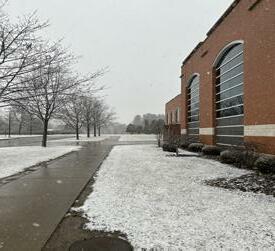
Columnist verbally fights defunct storage company.
The reward: her already-owned possesions.
THE MISCELLANY NEWS
EDITOR-IN-CHIEF
MANAGING EDITOR
CONTRIBUTING EDITOR
NEWS EDITORS
ARTS EDITOR
FEATURES EDITOR
OPINIONS EDITOR
HUMOR EDITORS
ASSISTANT HUMOR EDITOR
SPORTS EDITOR
ASSISTANT SPORTS EDITOR
SOCIAL MEDIA EDITOR
PHOTO EDITOR
DESIGN EDITOR
COPY EDITOR
ASSISTANT COPY EDITOR
GRAPHICS EDITOR
LIVE EVENTS CHAIR
VIDEO PRODUCTION MANAGER

WEBMASTERS
BUSINESS MANAGER REPORTERS, COLUMNISTS
Nina Ajemian
Monika Sweeney
Leila Raines
Jacques Abou-Rizk
Charlotte Robertson
Ganesh Pillai
Kai Speirs
Sufana Noorwez
Madi Donat
Nicholas Tillinghast
Nandini Likki
Doug Cobb
Nick Villamil
Tracy Cen
Igor Martiniouk
Maryam Bacchus
Caris Lee
Tiffany Kuo
Karen Mogami
Catherine Borthwick
Ian Herz
Rohan Dutta
Chloe Gjoka
Phoebe DiLeo
Emma Adams
Carly D’Antonio
Yaksha Gummadapu
Allen Hale
Jesse Koblin
Anna Kozloski
Richard Lu
Gwen Ma
Jyotsna Naidu
Sam Patz
Naima Saini
COPY STAFF
Anna Terry
Anica Acuna
Emma Goss
Willa Jewitt
Allison Lowe
Ailynn O'Neill
Emma San Filippo
Meera Shroff
Julia Weinberg
GRAPHIC ARTIST
Edward Welch Morgan
Tori Kim
CORRECTION POLICY
The Miscellany News will only accept corrections for any misquotes, misrepresentations or factual errors for an article within the semester it is printed.
The Miscellany News is not responsible for the views presented within its Opinions pages. Staff editorials are the only articles that reflect the opinion of a two-thirds majority of the Editorial Board.
ACCESS aims to confront inaccessibilities at Vassar
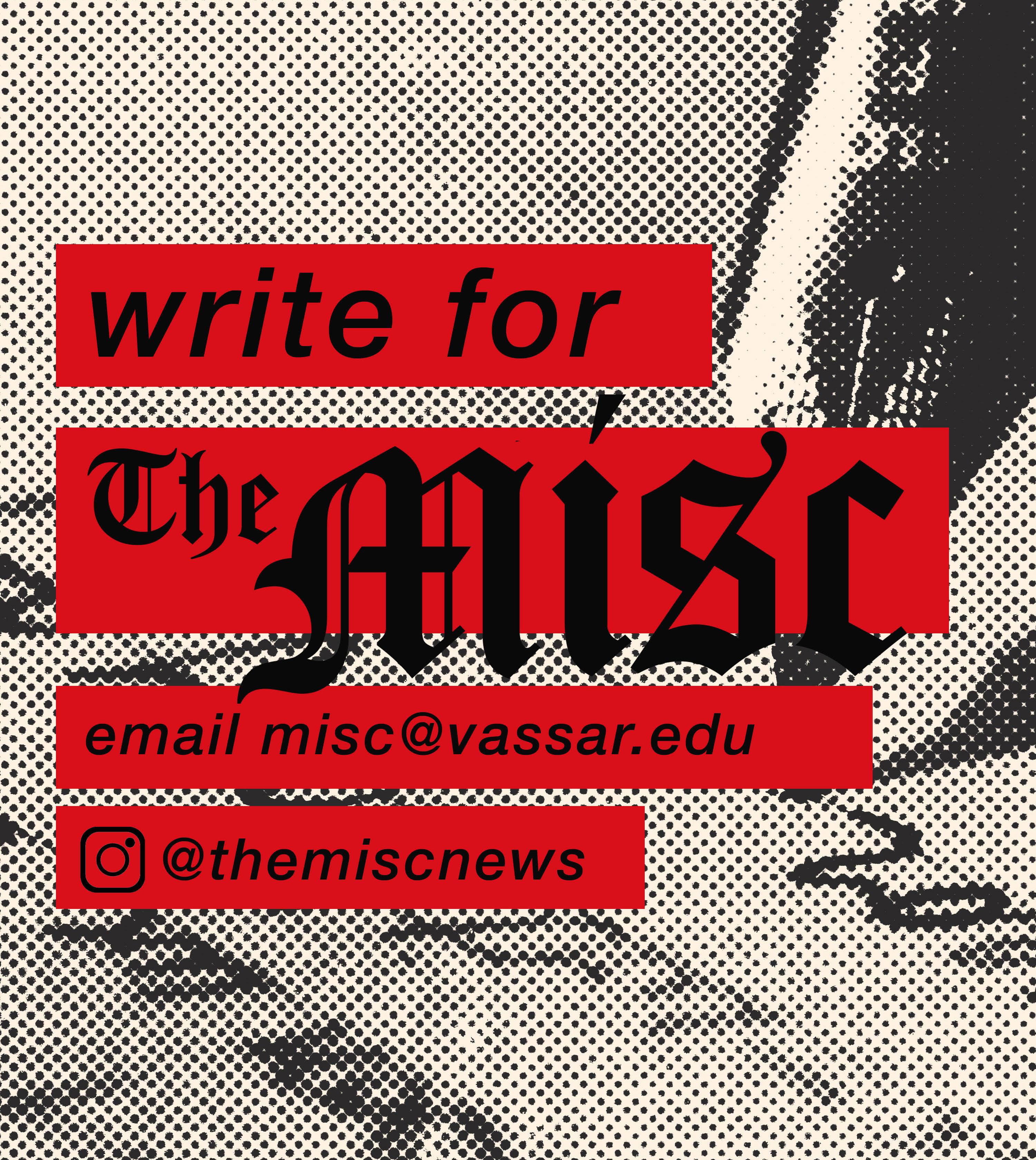
having difficulty completing my work and managing my anxiety. When I got to Vassar, I was so happy to have the AEO but it was super intimidating to approach them. I think I cried the first time I talked to them because I was so intimidated. I want students to feel more confident when advocating for themselves and their needs. I don’t want other students to access accommodations like I did in high school.”
According to Freilich, “The AEO is amazing but it is quite limited in what it can accomplish due to its small size and lack of student involvement. We would like to fill in the gaps by creating spaces
where disabled people feel like they can fit in and don’t have to hide their disability.”
Freilich said she noticed how inaccessible Vassar is when she entered as a freshman, and she hopes ACCESS can help minimize the accessibility inequalities faced by so many students. “I felt so alone when I entered college. I didn’t know how many people at Vassar shared similar experiences and it would have been so helpful to have an org like this as a freshman.” She added, “Some Professors also really have no idea what it means to be disabled and they need a lot of education.”
She added, “Accessibility and disability as an identity are two relatively new con-
cepts that the general population really don’t understand yet. In other words, the issues at Vassar are not isolated to this campus but are issues faced by us everywhere.”
For the upcoming semester, Freilich said ACCESS is just getting started on their agenda. “We have a lot of big goals that will most likely take years to implement, she said. “For this semester, we would like to improve the freshman orientation for the Fall of 2023 for those students with a disability. We would like to create mandatory training for Professors on disabled students’ needs and accommodations.”
Das emphasized the journey towards the goals that ACCESS aspires to achieve. She
said, “My hope is that this club can be a safe space for students with disabilities and that we are able to create a space where we can celebrate disability,” adding, “Having a place where I can not only accept my disability, but rather celebrate it, has been a very special experience and I hope that other students can have that too. “
Boswell ensured, “Anyone is welcome (and encouraged!) to join ACCESS, regardless of disability status. We simply ask that you come with an open mind and a willingness to help us achieve our goals. Our members will sometimes share stories that are very personal to them, so respect and trust are also essential.”
New Indoor Farmers Market fosters local business connections
Thursday, Jan. 26, marked the opening of the new Indoor Farmers Market. Moving forward, the market will be open every Thursday until May 4, from 11 a.m. until 5 p.m. in the College Center South Atrium, outside of The Retreat. Transitioning from its outdoor format in the fall and spring, several vendors were present at the market.
Meghan Williams started her company, Food to Write Home About, a year ago, selling baked goods both online and in-person to the people of the Hudson Valley. The idea was born after a close friend asked her to make desserts for a party, where she discovered her passion. At the Farmers Market, she has several varieties of pies, cookies and specialty items for sale. When asked why she loves selling at Vassar, Williams explained, “I’m excited to sell in this historical space; it’s cool to be able to come here. A lot of students are customers and I really appreciate that they spend their money on my baked goods.”
A second vendor, Meredith’s Country Bakery in Kingston, NY, is a specialty gluten-free, paleo-friendly, locally-sourced bakery that caters to those with dietary restrictions. After 50 years, Meredith’s Country Bakery is a staple of the Hudson Valley; in fact, even after the eponymous
Meredith’s death, the new owners still use her name and original recipes to honor her memory. They sell most of their baked goods in the tri-state area, functioning as a Hudson Valley landmark. Kevin, the salesman from the store, explained: “We’re on the way to Phoenicia and Woodstock, a very native type of area, and we provide the opportunity for something sweet on the way to both natural and cultural sites in the Hudson Valley.” When asked what sets Meredith’s apart, he quickly responded, “Buy local. It beats going to the grocery store, it’s a lot better for you digestively and health wise and it’s always great to support the local community.”
Another local artisan on offer, The Educated Chef, is a sourdough bread company with bread baked exclusively by Mark Doctoroff. He has been baking professionally for a decade and was a regular at Vassar’s outdoor markets before the COVID-19 pandemic. Now, he also sells outdoors at local markets such as the Arlington Farmers Market and the Poughkeepsie Waterfront Market. Doctoroff began baking bread for himself over a decade ago. After becoming unemployed, he decided to make baking his full-time livelihood. Doctoroff has grown his inventory to include several specialty breads for different occasions, such as Irish Soda Bread for St. Patrick’s Day and Ukrainian Easter Bread for Easter. Baking
isn’t merely his profession but his passion, as he explained: “I love baking bread, feeding people, seeing the smile on their face when they bite into it. I love seeing stuff that I make with my own hands bring joy to those around me.”
The Cooperstown Cheese Company, located in Milford, NY, approximately 100 miles north from Vassar, crafts local, artisanal cheeses, notably including its Toma Celena and Jersey Girl cheeses. The company specializes in European-inspired cheeses from primarily Jersey and Brown Swiss cows’ milk, and makes sure to only use milk from local dairy farms. Cooperstown Cheese Company takes the cheese from these local farms and ages it in its aging caves, which are both temperatureand humidity-controlled. Started by Bob Sweitzer and Sharon Tomaselli, who both transitioned from papermaking to cheesemaking, the business has become renowned for the high quality of its cheeses. Notably, both the Toma Celena and Jersey Girl cheeses were served at the 57th Presidential Inaugural Luncheon in 2013. Here at Vassar, Cooperstown Cheese Company sells its wares to students to enjoy and sample, and has been a fixture of the Outdoor and Indoor Markets for years.
The Vassar Indoor Farmers Market brings together the creativity and the products of some of the Hudson Valley’s finest
artisans, benefitting both the vendors and the student body. In the spring, the Farmer’s Market will transition back outdoors and will be able to accommodate more vendors than when inside the Main Building. Once it does, even more vendors will be able to bring their products for Vassar students to enjoy.
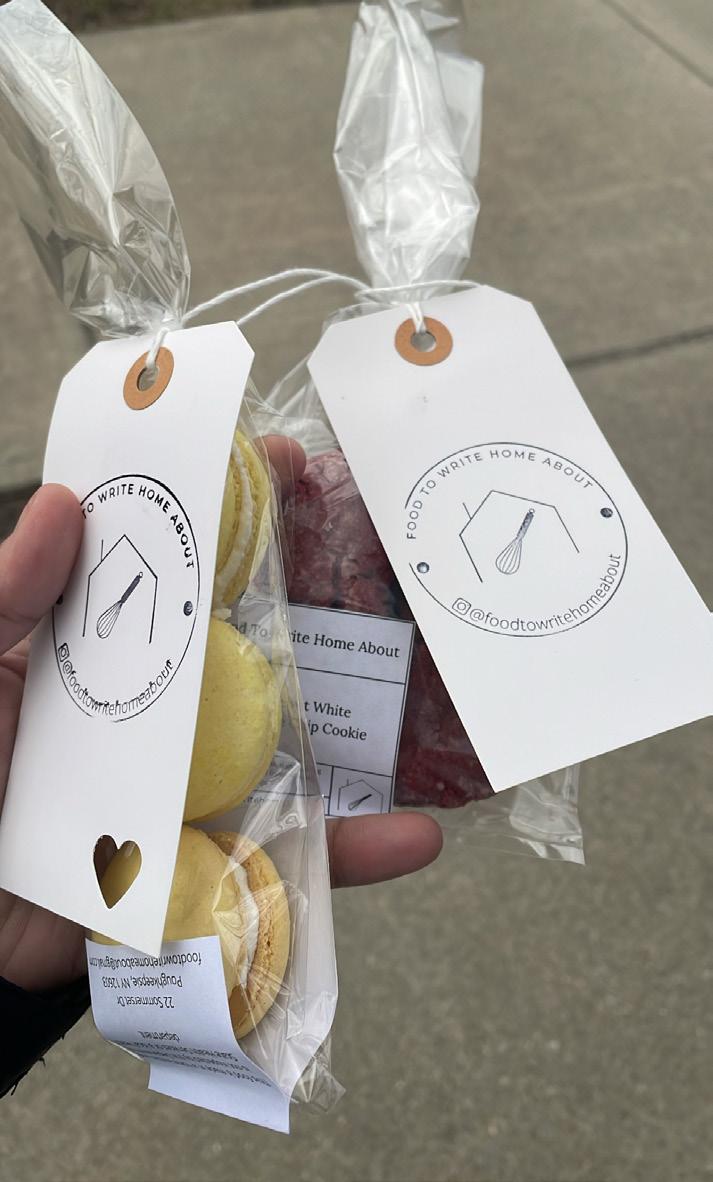
Highlighting the best and worst of reality TV
Naima Saini ColumnistThe winter break was dark and cold, and towards the end of it, I found myself very bored, despite the fact that I absolutely had things to do that I was procrastinating on. And so, I found myself grateful that “Too Hot to Handle” (THTH) and “The Circle,” two reality shows that I had watched all available episodes of, were both coming out with new seasons. The latest season of “The Circle” had extremely likable contestants, intriguing twists, and just a hint of romance. Unlike some past seasons, this one felt like it had players who were the right amount of strategic without being mean to each other all the time. “Too Hot to Handle” was extremely entertaining too, but as always, it was in a way that made me feel a little gross. Once I had finished these new installments and was looking for something else to stave off boredom, I started considering something— what makes for truly good reality television?
I’m sure this is a polarizing question because reality TV itself is a polarizing topic. Some people love it, some people hate it, and some people who love it hate that they do (sometimes I’m one of those).
Some of the genre’s most popular offerings are dating shows: “Love Island,” “Love Is Blind,” and “Married at First Sight,” to name a few. When romance is the focus, it’s not remotely difficult for interpersonal drama to pop up, allowing the viewer the extremely entertaining experience of taking sides without holding any stakes at all. “Too Hot
to Handle” definitely delivers on the drama. The premise is that people who have trouble forming authentic connections with others, usually opting for meaningless sex instead, are put on an island together and banned from kissing or doing anything more. Each time someone breaks the rules, the prize fund of $200,000 is depleted.
“Too Hot to Handle” annoys me a lot, and this recent season was no exception. I will say, however, that past seasons of “THTH” have made me want to yell at my screen much more than this recent one did. One of the reasons was that historically, the producers gave seemingly endless second chances to people (usually men) who were behaving badly. In Season 4, that wasn’t so much the case. After watching Creed, an infuriating man, try to get away with seeing two women and lying to them both about it, it’s a refreshing surprise when he actually faces consequences.
“THTH” has the ostensible purpose of encouraging people to form genuine connections, but the premise is confusing. First of all, the message surrounding the show’s stated goal and how it’s delivered definitely invokes some of the worst forms of purity culture. Also, despite seeming to preach that the only way to find real love is to refrain from having sex, breaking the rules doesn’t actually prevent people from winning—it just lowers the monetary reward. On the flip side, people who remain single for long enough are often kicked off of the show, based on the idea that they aren’t trying hard
enough to make a connection. And except for in Season 1, where the prize was split between all of the finalists, no one who was single at the time of the finale has been able to win. This bothers me a lot because I think that refusing to make a fake connection with someone you don’t really like for the sake of winning is actually very in line with the message the show pretends to be upholding. The fact that this isn’t how the show actually works is a testament to how false the premise is. My main issue with this isn’t the way the show is handled, but rather how disingenuous it is—I wish the producers would stop pretending the show is an exercise in morality rather than a deeply vapid project.
In contrast, “The Circle,” which I enjoyed much more, is, at its core, a popularity contest. The ultimate goal is to be highly ranked by your fellow players, who you never see — everyone lives separately and only interacts using an online social-media-like platform called The Circle. Part of what makes the show appealing is that, due to this structure, there is nothing stopping players from catfishing and posing as someone else. Many of the twists and games are clearly designed to stir the pot, start arguments and plant seeds of doubt in the minds of the players. But “The Circle” is not pretending to be something it’s not.
While the show doesn’t try to make grand sweeping generalizations about life and authenticity, , many of the players have heartwarming stories or interesting reasons for catfishing—or for being themselves. I much
prefer this style. On a dating show, it’s hard to know who’s being fake and who’s just trying to win. While contestants on “THTH” are always mad at each other about losing money, it’s not really acknowledged that some people might be motivated to pair up because they’d have a higher chance of winning. On “The Circle,” because everyone is separated, you get to hear contestants talk about their motivations. Of course, it’s clear that not every thought is voiced, but it weirdly feels more authentic to hear someone explain their strategy behind being fake than it does to see someone behaving that way without acknowledging it.
While its latest season was branded as the “singles season,” at its core, “The Circle” is not meant to be a dating show. Because of this, friendship shines through as the most important kind of relationship. Chaz, Sam and Raven, who many considered the most popular contestants of the season, developed a close friendship that I frankly found lovely to see. I don’t know whether it’s about the casting or about the format—it’s probably a mixture of both—but I wish more reality TV would allow us to see real friendships develop instead of focusing exclusively on romance.
At the end of the day though, I watch both shows because it’s fun watching people be messy on television, so you might want to take what I say with a grain of salt. But I will say that, despite being a literal popularity contest, “The Circle” left me with a much better taste in my mouth.
Wrapping up an understated, quality musical month
Ganesh Pillai Arts EditorListening to more music feels like a copout New Year’s resolution. Of course, discovering more artists to binge and songs to stream for hours on end is a goal for many. And as January has already passed, I saw myself looking back to 2023’s early birds and eager entrants. In a month that couldn’t boast many full-length releases from industry megastars, there were still many tracks worthy of being played on repeat during a wintry walk to class or to transportive oneself away from snow into the sun.
“Casa Lopez” – Venna, Masego, Mick Jenkins
Those in search of an escape to warmer climates and pining for the ease of long summer days should turn no further than the track “Casa Lopez.” Singer-songwriter Masego (of “Tadow” fame) teamed up with London producer and saxophonist Venna and Chicago rapper Jenkins to bring us this relaxed, dreamy track. Boasting the smooth saxophonic signature of many of Masego’s other works, Venna’s expert instrumentation provides the perfect interlude between Jenkins’ punchy,pronounced verse and Masego’s delicate hook. The song’s light drums throughout, underlying its ethereal horns and strings, conjure up images of a faraway island, where listening to such a tropical track would feel much more fitting. But still, “Casa Lopez” is a reminder that despite the freezing temperatures now, a languid, lounging beach day is only a blink away.
“the BLACK seminole” – Lil Yachty Atlanta rapper Lil Yachty teased us with his more melodic side on various tracks throughout past albums, even collaborating with superstar Tame Impala and providing an excellent guest verse on the Australian act’s
song “Breathe Deeper.” That said, Lil Yachty releasing a full-length, experimental rockrap fusion album wasn’t expected by most hip-hop fans, but that is exactly what “Let’s Start Here” is. I want to highlight the album’s intro track: a grand entrance to a dizzying and otherworldly-produced project. Evoking inspiration from fellow modern artists’ utilization of guitar solos and other rock elements (artists such as Childish Gambino and Travis Scott come to mind), “the BLACK seminole” welcomes Yachty to the stage of psychedelia. With its unabashedly loud drum fills, musical breaks and prominent bass guitar, Yachty’s voice echoes and pulses through the six-minute track teeming with rocking energy. In an album that takes fans on a journey through a brand new, untouched world for Lil Yachty, “the BLACK seminole,” is the “bon voyage” to commence a trip to unknown destinations with the full confidence that it will be a good time.
“Mt. Fuji” – Kota the Friend
Chicago rapper Kota the Friend has made an aesthetic and career of going against the cultural grain and neglecting mainstream trends for an unapologetically personal style. Prioritizing genuine storytelling and rapping above all else, the song “Mt. Fuji” features the mellow, relaxed lyricist expressing the joy of finding inner peace over a fittingly airy piano riff: “Not pretentious, it’s messy when your ego is boasted / Now you at the mercy of fickle-minded people and jokers.” Within a world dominated by voices bragging about conquering foes, amassing wealth and besting the competition, Kota is the foil. And while I do appreciate those other voices for their lane and capability of producing high-quality music, to see emcees like Kota bragging about being friends with his neighbors and not having enemies is a welcome change of pace. “Mt. Fuji,” like the larger work it is a part of, is a laid-back, relaxed track that allows listeners
to revel in the little moments of calm in an otherwise hectic world. The track embraces standing your ground against oppositional forces.
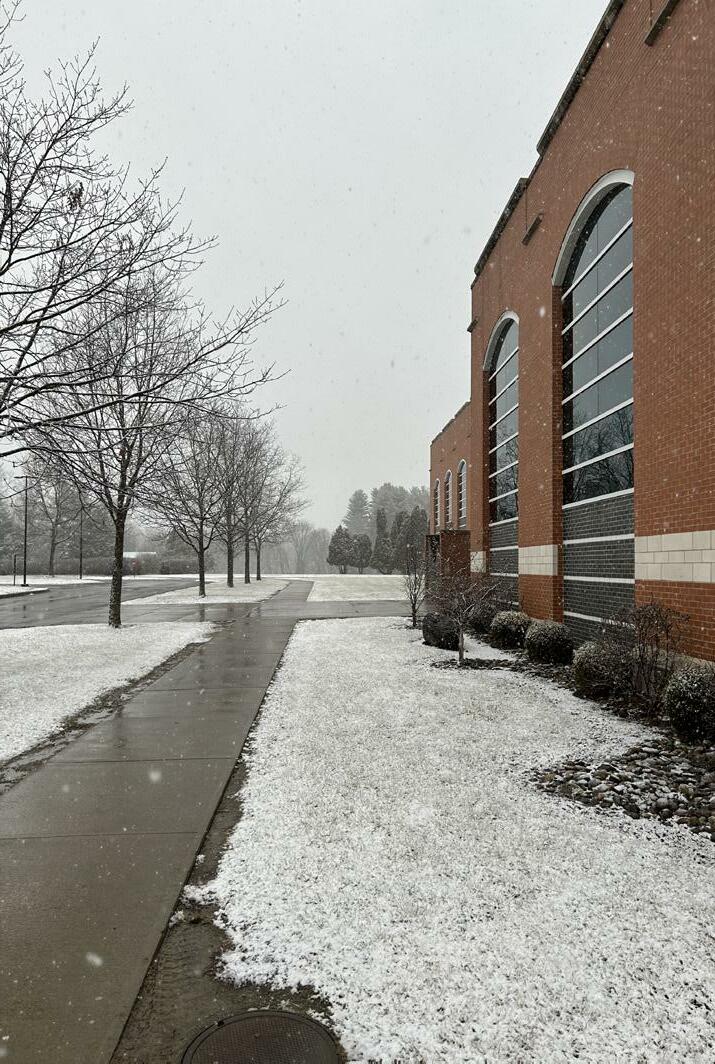
“Selfish” – Slowthai Originality in hip-hop is harder to come by with each passing generation of artists, but England’s eclectic, irreverent Slowthai manages to stay unique. His seminal album “Nothing Great about Britain” (2019) remains one of the freshest projects in UK Grime, if it can even be boxed into such a genre. He followed it up with a work of similarly high quality in the album “TYRON” (2021). Now, the artist has returned with “Selfish” as the lead single teasing his upcoming project, “Ugly” (which stands for “U gotta love yourself”). “Selfish” is a hard-hitting, reverb-heavy, darkly-toned song seemingly destined for underground pubs and seedy spots. The singer alternates between a steady, meditative delivery and a raspy, growling one, lamenting how people try to emulate his style—a futile pursuit. Tyron’s aggressive, angry chorus of, “I’m just thinkin’ for myself / Thinkin’, I'm just thinkin’ for myself” not only encapsulates his frustration with the unimaginative voices of the industry, but also demonstrates, through its own merit, just how much Slowthai has separated himself sonically from his wouldbe competition.
“Do You Like Me?” – Daniel Caesar “Ask and you shall receive” seems to be the mantra for fans as the ever-elusive Daniel Caesar released the fittingly interrogatory single “Do You Like Me?” this past Friday, presumably in the leadup to a new album this year. Only his fourth single in more than two years, Caesar is primed to debut a new fulllength project for the first time since 2019. The singer’s latest is an example of Caesar doing what he does best: crooning love songs over simple beats. Gentle guitar strums and
a nonchalant, almost behind-the-beat drum pattern allow the artist’s biggest strength—his voice—to shine. His yearning, clawing hook, “Do you really like me, Do you really like me?” leads wonderfully into the tentatively optimistic, “I guess we’ll find out / I guess we’ll wait and see.” Caesar expertly conveys both his desperation and his hope in a track that walks the listener on a familiar stroll of emotions, resulting in a musical experience both relatable and sonically enjoyable.
For a month of new beginnings, the same old routines and everything in between, these five songs are a few of my musical backdrops to a time when we may or may not be forming the foundations for unknown possibilities. But that’s why music is so stubbornly persistent in our lives. Whether it be a snowy January morning or a sunny evening in July, allow us to adapt to our surroundings, be it embracng them, or taking us to distant places.
MODfest explores displacement in 'Requiem for Ashokan'
Continued from MODfest on page 1
By June 2017, she had a full exhibit including over 40 works of art, a sound installation and handmade artist’s books. When asked about her favorite part of this project, McGloughlin said, “It felt like I did something for my family. That was really meaningful to me.”
Meanwhile, Beisaw had already been researching the Ashokan Reservoir area for
five years for her book “Taking Our Water for the City: The Archeology of New York’s Watershed Communities,” but she started to hit a wall: “Nobody in the local community would talk to me because everybody thought I was being paid by NYC.” From the many people she spoke to, one common refrain was to get in touch with McGloughlin. Once they finally met and began working together, Beisaw was able to learn from
McGloughlin’s collection of records, stories and photos. Beisaw remarked, “Things just opened up, my understanding really skyrocketed.”
An image of McGloughlin’s family property graces the cover of Beisaw’s book, and one of McGloughlin’s poems is also included. Bseisaw noted that over 100 Vassar students contributed to the research on the Ashokan Reservoir. Now their research and
McGloughlin’s family story and art-making are meaningfully connected.
Beisaw also noted that McGloughlin’s exhibit reminds us that not all displaced peoples are victims of distant wars. She added, “It’s great to be involved in all of that internationally, but I think you always have to be worried about what is going on around you.”
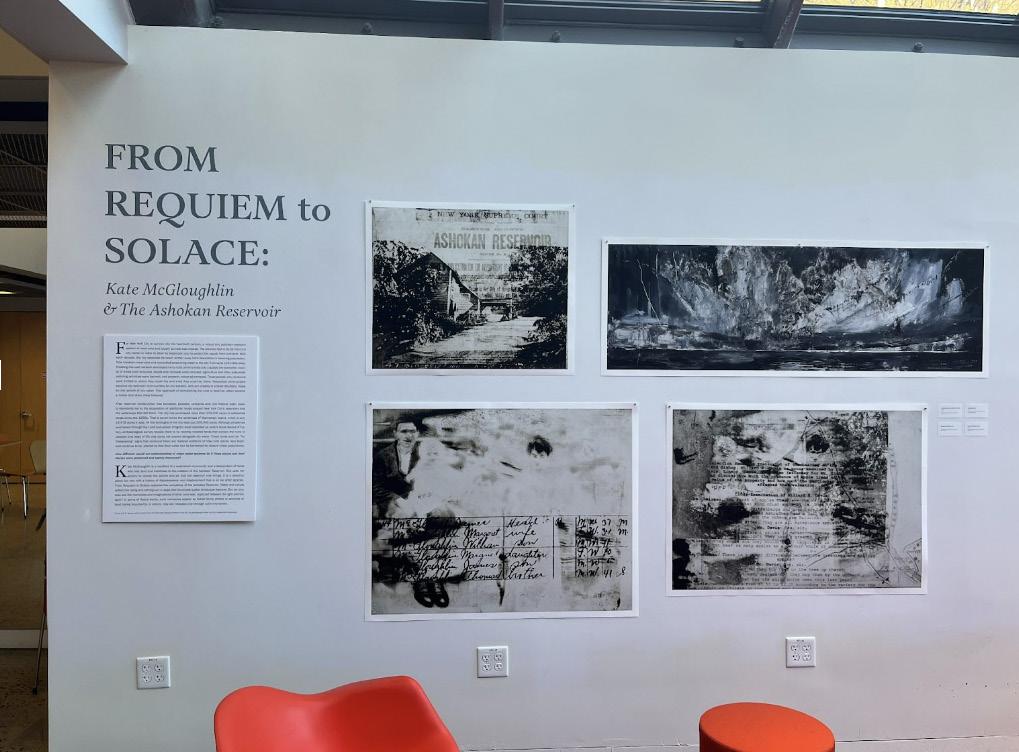
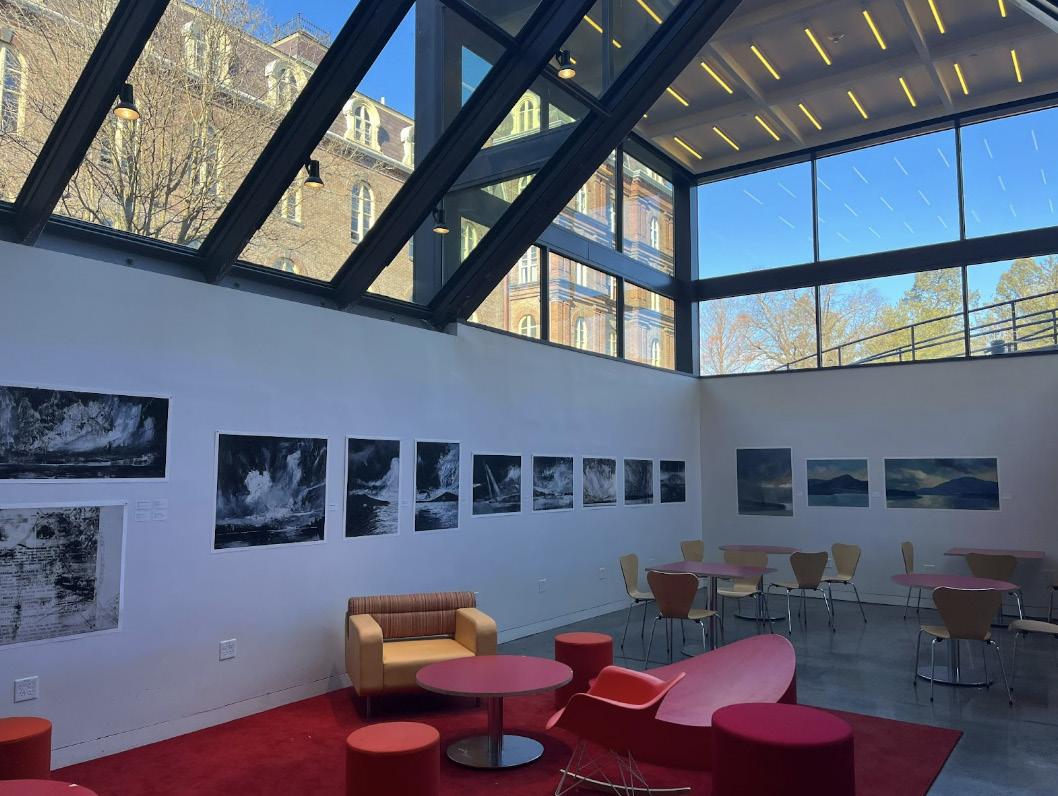
“Requiem for Ashokan” will be on view in The Old Bookstore through Feb. 19.


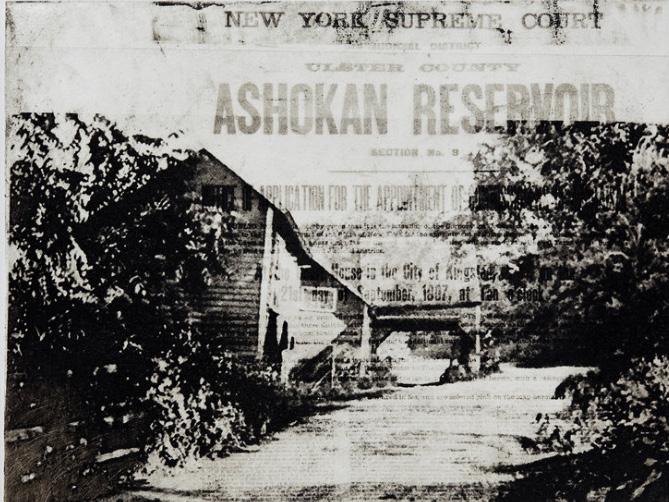
Celebrating the blissful Lunar New Year at Vassar
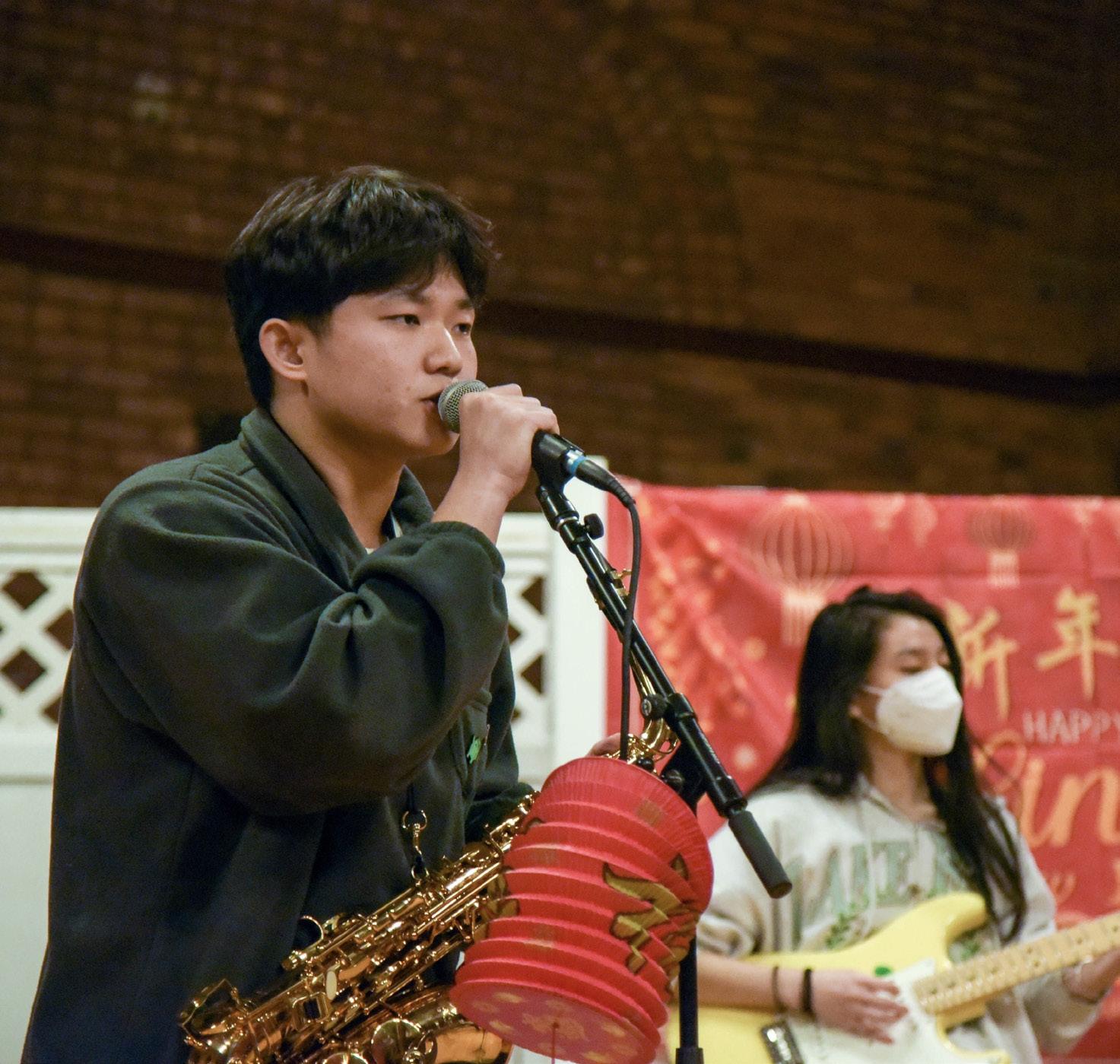
Continued from New Year on page 1
other students, she performed “Attention” by NewJeans with fun K-pop dance choreography. Liu thought the preparation leading up to the Spring Festival was by far the most memorable. “Practicing the dance was my favorite part about the entire process,” Liu said. “The five of us bonded over this dance and became closer than before.” As this was the only English song of the evening, the performance stood out from the rest. “I hope [our performance] brought a lot of energy to the audience and cheered everyone up!” Liu remarked.
As President of the CSC, Xu was responsible for organizing the event. However, this didn’t stop her from performing as well.. Together with Yining Shang ’25, she performed a contemporary version of Peking opera called “神女劈观” by 剧情. Both Xu and Shang worked tirelessly to ensure their performance paid homage to traditional Peking opera. “I don’t have much experience singing Chinese traditional opera, so I listened to a lot of different versions of this song sung by professional opera singers,” Xu recalled. “While this song is not strictly a piece of Peking opera… I still hope that our performance could get more people to be interested in this art form!” Xu
and Shang gave their all during the performance. Shang thanks her friends for being there in support of their goal. “My favorite part of this process is… when we practiced in Skinner, some of our friends who were also in Skinner at the time… listened to our song [and gave] us some advice,” Shang explained. “Having someone else [listen to our song] before the performance really made a difference.”
The Spring Festival was a very meaningful event for many Chinese international students, such as Vice President of the CSC, Carina Jiang ’24. “Because everybody is far from home now, we want this event at Vassar to be a chance to at least celebrate with our friends when we are not with our families,” she said. “This is the biggest celebration of the whole year for all Chinese students.” Shang had a similar experience during the event. “The recurring music played during [the] Spring Festival is a vital part of my memory at home and getting to hear [it] again with people together makes me feel at home,” she said. Approximately 7,200 miles and 15 hours away from home, the Spring Festival brought the Chinese international students together for a night of fun and laughter. Thanks to the efforts of CSC, Vassar is no longer just a foreign country, but a second home for many.
Meet Rafa: The Amazon Hub Locker that no one knows about
of Charleston. The decision to install Rafa was ultimately reached to improve service for the Campus Community. Vassar did not pay any purchasing or installation costs for the unit.
It stands still and sturdy, hidden in the shadow of Jewett's tower. The segmented lockers join together in a rectangular prism of cool metal and matte grey. It is unassuming, but powerful. It is silent in its existence, but its message is clear: "Order a Amazon, pick up here." No one knows if this is a grammatical error or a puzzling riddle. Nonetheless, Rafa stands confidently in its lonely corner; it is none other than an Amazon Hub Locker.
Amazon Hub Lockers are nothing new, having been rolled out to the public for the first time in 2011, according to Business Insider. You might have seen them in Whole Foods, Rite Aid or other businesses that have partnered with Amazon to install these automatons. The Amazon website boasts the ability to self-serve in both collecting and returning packages through these lockers. One of the major advantages they posit is the locker's ability to work around the schedule of the customer. We all love the beautiful walks to Central, but the 4 p.m. closing time is less than accommodating. Therefore, these lockers could proudly serve and enable night owls, busy bodies, 9-5'ers and I-don't-wantto-get-out-of-bed-to-walk-to-central'ers.
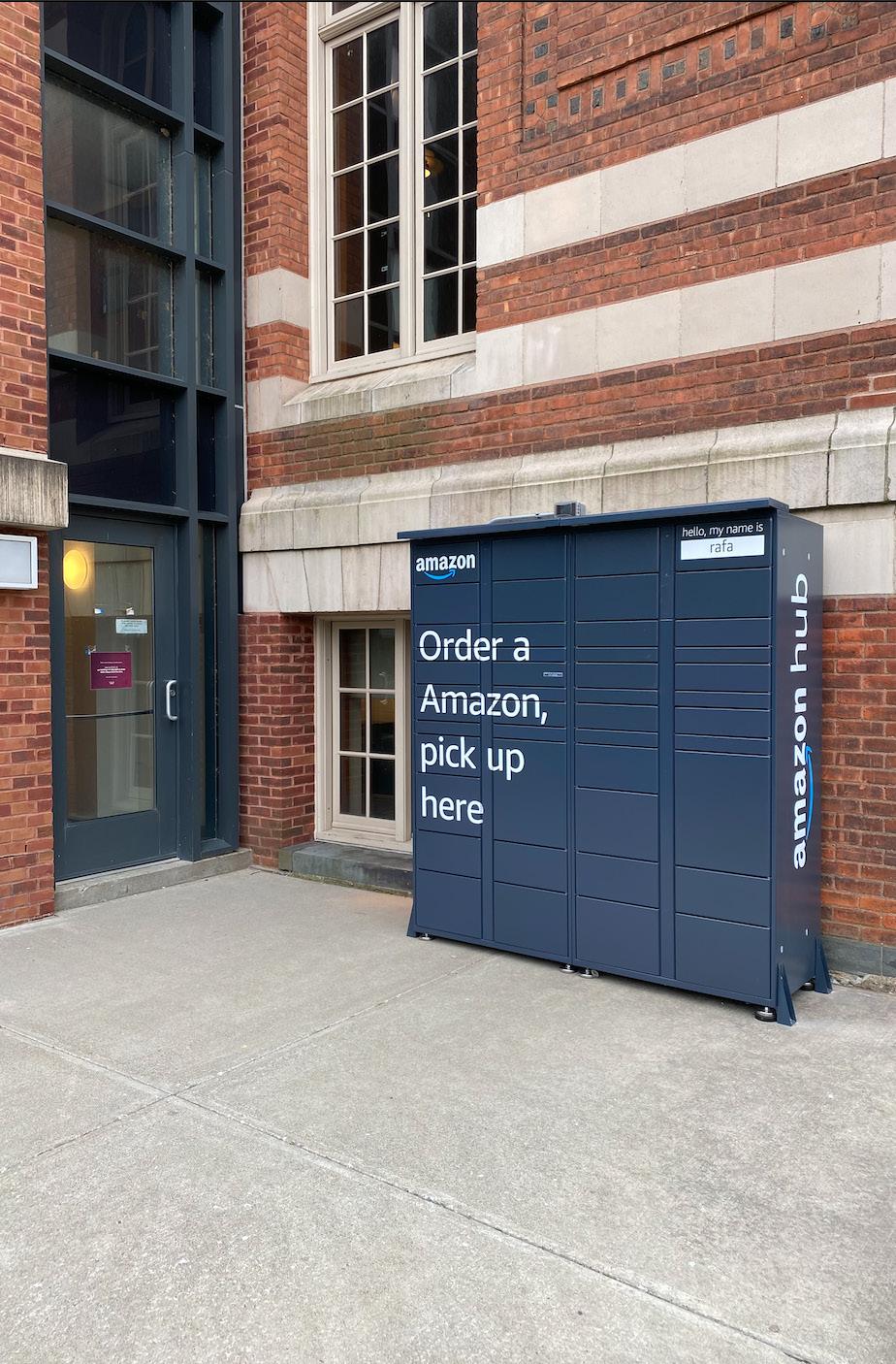
They do impose a time limit of three calendar days by which you have to pick up any packages; this information is provided at checkout. Finally, there are only certain eligible items that can be delivered to these lockers—those of dimensions 16 by 12 by 14 inches with a weight of 10 pounds or less—so it's not the end-all-beall solution for deliveries to and from campus.
The campus welcomed our new student, Rafa, on Jan. 18, 2023. Rafa is a bulky 48-locker unit happily ensconced in its corner of the Jewett parking lot. As to how this unit ended up on campus, I spoke to Director of Procurement and Auxiliary Services Rosaleen Cardillo.
Cardillo commented, “Amazon approached the College to partner as they are doing with many other colleges and universities.” Over the past few years, Amazon has done similar installations at Boston College and the College
Cardillo continued in stating that the process of installation was not motivated by an incentive or connection with Amazon, but through the data and trends they have seen in Amazon deliveries. The number of Amazon packages that filter through the Mailroom and Central Receiving is growing, and despite our best efforts to shop locally we as a community have contributed to that. For those of us who went through the Vassar bubble, COVID-19 era, the inability to leave campus to obtain basic goods left us with a default mentality to order online. Regardless of how we have contributed to the trends, the fact remains that Vassar receives a number of Amazon packages each day. This unit provides an alternative collection point for such deliveries which could decrease the stress on both the Mailroom and Receiving, resulting in faster processing times and overall increased service.
Let's tackle the elephant in the room: It's Amazon. The company is famous for inhumane treatment of its employees. The heavily advertised unit of lockers represents a partnership between Vassar and Amazon, something that appears antithetical to some student's opinions. Slightly less invasive than the elephant, but still prominent is the manatee in the room: What about small businesses? I approached Cardillo with the fact that Vassar prominently encourages students to support the restaurants and stores on Raymond Avenue and beyond. Munchie Mondays, Tasty Tuesdays, Farmers' Markets and Arlington Bucks are all Vassar-run incentives aimed to motivate students to engage with local vendors. Despite these efforts, they chose to support a bigger brand like Amazon through this locker. Cardillo responded: “Vassar will continue to support small and community businesses in the area.” However, she once again indicated, “Amazon approached the College about this opportunity because of the volume of Amazon packages regularly sent to the campus.”
The College is in the process of finishing
testing on the unit and releasing its own announcement, but in the meantime, I've stepped into the role of "Amazon-Locker informer." While my friends were sufficiently tired of hearing me talk about it, each one of the 15 students I spoke to were rather mystified about its presence on campus. Not one of them had heard about it, and many expressed their confusion, others apprehension, some bewilderment. In general, there was a shared response of why? After speaking to these students about their ordering habits, I was met with the sobering realization that it's not too cool to order from Amazon anymore. None of them had gone cold-turkey, as they all admitted to ordering from Amazon a few times a semester for the odds and ends of living, but they each maintained that it was not frequent enough to warrant an Amazon-specific dropoff point.
Regardless of where they live on campus, the consensus was that this unit is not relevant to Vassar's culture. Nate Grosjean '24, a Raymond resident, and Pooja Huded '25, a proud Jewett owl, highlighted that the walk to Central is a nice incentive to get outside and breathe some fresh air. Common was the idea that having a dedicated space for Amazon packages encourages a big-box, capitalistic identity. Huded continued in saying she doesn't "think we should or need to support such a large corporation… that is already reaping profits by underpaying and mistreating employees, as well as by fostering a culture of reckless consumerism." Despite its convenience, the unit embodies a materialistic mindset that is unbecoming on Vassar's campus.
Risking my popularity, I took it upon myself to test Rafa's potential. Having received an email that my package was ready for pick up, I ventured out into the cold to collect my loot. Rafa uses bluetooth and the Amazon app to ensure a secure pick-up. Once connected, I pressed "pick-up" and, like magic, the box containing my Aveeno moisturizer revealed itself. Those around me heard my squeals of excitement and awe as I removed my box, closed the door and left Rafa to its devices. I would absolutely do it again.
Rafa served me well, but I understand the
apprehension towards the unit. While it does feel pivoted towards supporting one particular brand, I feel confident that it will serve as a mechanism to redistribute Amazon packages across campus. Based on my conversations with students, I don't believe this will lead to an increased frequency of Amazon orders, but it will provide alternative locations for pickup. Those who do not frequent the Amazon website will continue to be unimpressed by the company, while those who do may be relieved at having a more localized collection point. Having picked up my package on a Monday evening, I was not subject to the hours of operation by Central Receiving or the Mailroom. While my lotion was not a high-priority item, this accessibility could be invaluable for those who need immediate access to items on weekends or evenings. If you're interested, give Rafa a chance. Do your part to support small businesses first and foremost, but if you find yourself placing an Amazon order send it to Rafa. Take that nap from 3 to 4 p.m. and miss the Central window. Order something on a Saturday, and receive it on a Sunday. Go wild, but always try to buy responsibly and sustainably!
Ali’s Smith ‘Winter’ is a novel of the earth
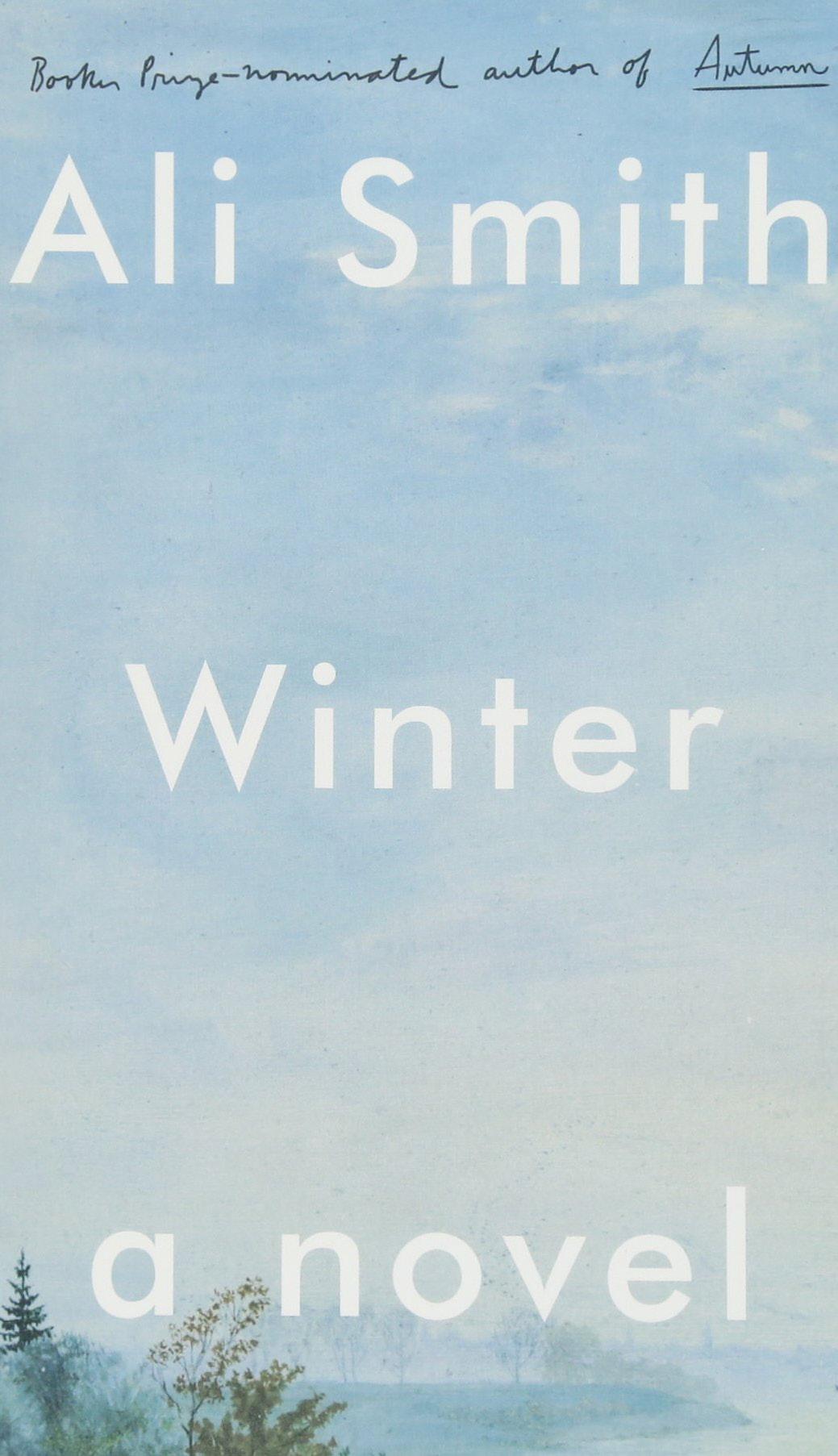 Anna Terry Columnist
Anna Terry Columnist
Released in 2017, “Winter” marks the second installment in Ali Smith’s seasonal quartet. Although each novel has its own distinct plot and characters, and thus the four books can be read in any order, the quartet builds upon immutable themes to create a literary sequence that mimics the natural rhythms of the year. I discovered Ali Smith’s novels with the first in the quartet, “Autumn,” which I read over October Break.
When I read “Autumn,” I didn’t exactly plan to read the future novels during the seasons that inspired them, but by the time Winter Break came around, I found myself needing a new story. Smith’s “Winter” was the one I landed on.
The narratively disorienting, yet seemingly fluid novel focuses on the Cornwall Christmastime gathering of a woman named Sophia Cleves, her sister Iris, Sophia’s twenty-something year old son Art and a homeless Croatian lesbian named Lux, whom Art has paid to pretend to be his now-estranged girlfriend, Charlotte.
For work, Art, the novel’s protagonist, watches films to find and report copyrighted material. But his real passion lies in the nature blog he runs, cleverly titled “Art in Nature.” However, since his break-up, his ex-girlfriend Charlotte has taken control of the blog, publishing purposefully incorrect content to humiliate him online. Art is an insecure, solitary character. He isn’t the person he wants to be—a serious naturalist and blogger—but rather someone who spends more time scrolling through Twitter than he does walking in the woods.
And yet, Art seems to have the power to reunite estranged forces, namely his mother Sophia and her sister Iris, who have not spoken to each other in over three decades. Art calls Iris when he arrives at his mother’s home and realizes she lacks sufficient food for the impending holiday. Enter Iris: a vigilant political protestor in her 70s, who loosely co-raised Art with Sophia. The
reunion of Sophia and Iris is thick with tension and opens a narrative of nostalgia, social and political differences and skeletons in the closet.
Just as the dynamics that fill the family gathering reach a breaking point, Lux arrives, pretending to be Art’s (now former) girlfriend Charlotte. I found Lux to be the most fascinating character in the novel— the significance of her personage is evident in her name, meaning “light.” As the havoc of estranged sisters throwing insults at each other, Sophia’s encounter with a floating head (evidence of her slow mental deterioration) and Art’s decrepit love life crescendos toward chaos and confusion, Lux appears as complete clarity—she is able to tell the truth, even failing to lie long enough to conceal her true identity.
Smith employs political commentary along with Shakesperian and Dickensian references throughout “Winter,” but her strongest cultural allusion is to the art of Modernist sculptor Barbara Hepworth. This connection to a female English artist is one of the threads that runs throughout all the novels in the seasonal quartet. But while Pauline Boty’s art played an immediate and tangible role in “Autumn,” the significance of Hepworth’s abstract, holey sculptures is more metaphorical. Smith’s comments on Hepworth and her work are sparse, but this description stood out to me in particular: “Yes, he says, and she does that, Hepworth, I think, puts the holes through what she makes, because she wants people to think about exactly what you just said, time, and ancient things, but also because she really just wants them to want to touch what she makes, you know, to be reminded about things that are quite physical, sensory, immediate, he says.”
In many ways, “Winter,” like Hepworth’s sculptures, is a novel about empty space and how we reckon with it. Just as Art faces the empty space of his father’s absence, Smith forces her readers to reckon with the holes in her narrative. She grabs the past and layers it over the present until it is unclear what time we are existing in at
all, and what, precisely, is real and what is imagined.
The story moves forwards and backwards through time, ruthlessly approaching past iterations of the characters’ selves, but never quite coming close enough to give us a perfect understanding of who they are. Smith’s novel is not quite a narrative, but a collection of moments held together, like snowflakes cupped in one’s palm— each is related, yet distinct and incredibly transitory. She forgoes quotation marks, deliberately blurring the line between dialogue and descriptive experience. As the novel flickers between years, revealing important instants and conversations in these characters’ lives, the narrative begins to fade away. By the end, we are left with no real resolution to the events that have transpired in this Cornwall home, just the vacancy of the space this story briefly held. Smith’s ending reminded me of the concluding lines of T. S. Eliot’s “The Hollow Men”—“This is the way the world ends/ Not with a bang but a whimper.”
This novel drew me to consider how the temporal calendar we directly experience and physically engage with year after year is reflected in our mindsets and lives. I’ve found that in the last six months or so, I’ve started to pay attention to how the earth’s rhythm mimics the flow of my own life. In autumn, the leaves dry and curl and fall to the ground. We must let go. In winter, the land is muted by snow and empty, bitter air. We are presented with a barrenness, a quietness, a painful, dimly illuminated peace that is necessary for the warm resonance of spring.
Early in the novel, Smith defines winter herself. She writes, “That’s what winter is: an exercise in remembering how to still yourself then how to come pliantly back to life again. An exercise in adapting yourself to whatever frozen or molten state it brings you.”
As much as the inevitably natural changes and effects of winter can be refracted through our own selves and personal experiences, they can also be transposed onto
the page. Smith does this in “Winter,” exploring the condition of the season through dreamy, disorienting, almost translucent prose.
Even though “Winter” revolves around a sense of both internal and external grayness that we are all too familiar with this time of year, Smith’s story is equally hopeful. She describes how the solstice doesn’t mark the absence of light, but the coming of it. She writes, “There was this different quality to the light even only four days past the shortest day; the shift, the reversal, from increase of darkness to increase of light, revealed that a coming back of light was at the heart of midwinter equally as much as the waning of light.”
With this, Smith suggests that maybe winter is not a season of perpetual grimness, but a waiting period, a growing period, a crucial moment of reunion with the self and family, before the inevitable blossoming of spring.
‘Daisy Jones and the Six’ is a must-read before release of TV series
 Emma Adams Columnist
Emma Adams Columnist
Over winter break, I pulled myself out of a nearly six-month-long reading slump with Taylor Jenkins Reid’s novel “Daisy Jones and the Six.” Chronicling title-character Daisy Jones’ odyssey to international fame in the ’70s, “Daisy Jones” is a portrait of sex, drugs and drama. Written in an interview style that often makes for amusing contradictions of truth, the book jumps from character to character, giving readers first-hand accounts of life as rock and roll legends in the seventies.
Daisy Jones, the neglected daughter of two well-known L.A. socialites, was effectively raised by Hollywood's biggest stars. By her early teens, Daisy was sneaking into clubs and making a name for herself with her effortlessly good looks and powerful voice. The thrill of sleeping with rock stars and the pull of party drugs sweeps Daisy into the entertainment underbelly of Hollywood, quickly catching the watchful eyes of big-name record labels.
Also gaining traction in the ’70s is a band called The Six, consisting of brothers Billy and Graham Dunne, drummer Warren Rhodes, bassist Pete Loving, guitarist Eddie Loving and keyboardist Karen Sirko. Billy has a cocky and highly opinionated presence,
quickly asserting himself as leader of the band and vocals. The group’s on-stage energy is apparent, but its track to stardom is impeded by one missing piece. A producer soon realizes the key to the band’s success is to pair them with rising star Daisy Jones, founding the supergroup Daisy Jones and the Six.
The fictional band is an obvious nod to Fleetwood Mac, a ’70s rock group famously riddled with adulterous drama and a public split at the height of stardom. Similarly, while Daisy and Billy have a rare and distinctive on-stage chemistry, behind-the-scenes tensions run high. Daisy’s addiction to drugs and dependency on partying creates a difficult environment for Billy, a recent graduate of rehab struggling to stay sober. Additionally, Billy’s ego and arrogance partnered with Daisy’s desire to be free from the controlling grasp of men makes for a volatile and problematic collaboration. But when their talent collides just right, the pair’s songwriting abilities are explosive. When they manage to produce their debut album “Aurora,” fans are hooked. The band finds itself catapulted into international fame, which only heightens drama within the group.
If you need further motivation to pick up “Daisy Jones and the Six,” look no further than its adaptation to the screen. A 10-episode miniseries is set to premiere on March 3 on Prime Video, the first trailer having been
released just a week ago. Playing Daisy is Riley Keough, coincidentally the granddaughter of the “The King of Rock and Roll” himself, Elvis Presley. Sam Claflin has been cast as Billy, most beloved for his role in “The Hunger Games: Catching Fire.” Notable supporting actors include Suki Waterhouse and Camila Morrone, along with other relatively undiscovered talent.
The star-studded cast has fans eagerly anticipating the show’s release. Further, many are excited to see how the miniseries adapts Jenkins Reid’s lyrics into recorded songs. The book provides thorough insight into each hit song from the band, including detailed accounts of Daisy and Billy’s chemistry on stage and a chapter at the end of the book dedicated solely to their lyrics. The trailer provides excerpts from “Regret Me,” one of the band's most emotional tracks featured on the album “Aurora.” Now available on Spotify, the song is an emotional tribute of Daisy’s unrequited love for Billy.
Along with obvious themes of addiction and relationship struggles, “Daisy Jones” includes issues of abortion and reproductive rights, complex feminist narratives and, of course, rock and roll. The poignancy of these issues accompanied by the completely unhinged nature of ’70s stardom are a deadly combination, creating an endearing cast of characters. However, the most enticing
aspect of “Daisy Jones” for me was the book’s multiple-perspective style and easily manageable page count. The uncomplicated writing style makes for a fast-paced read that can be devoured in a weekend. With the miniseries’ release date nearing, I encourage you to give the book a read. Grab a copy of “Daisy Jones,” turn on some Fleetwood Mac and enjoy.
Exploring benches through the lens of ‘Anna Karenina’
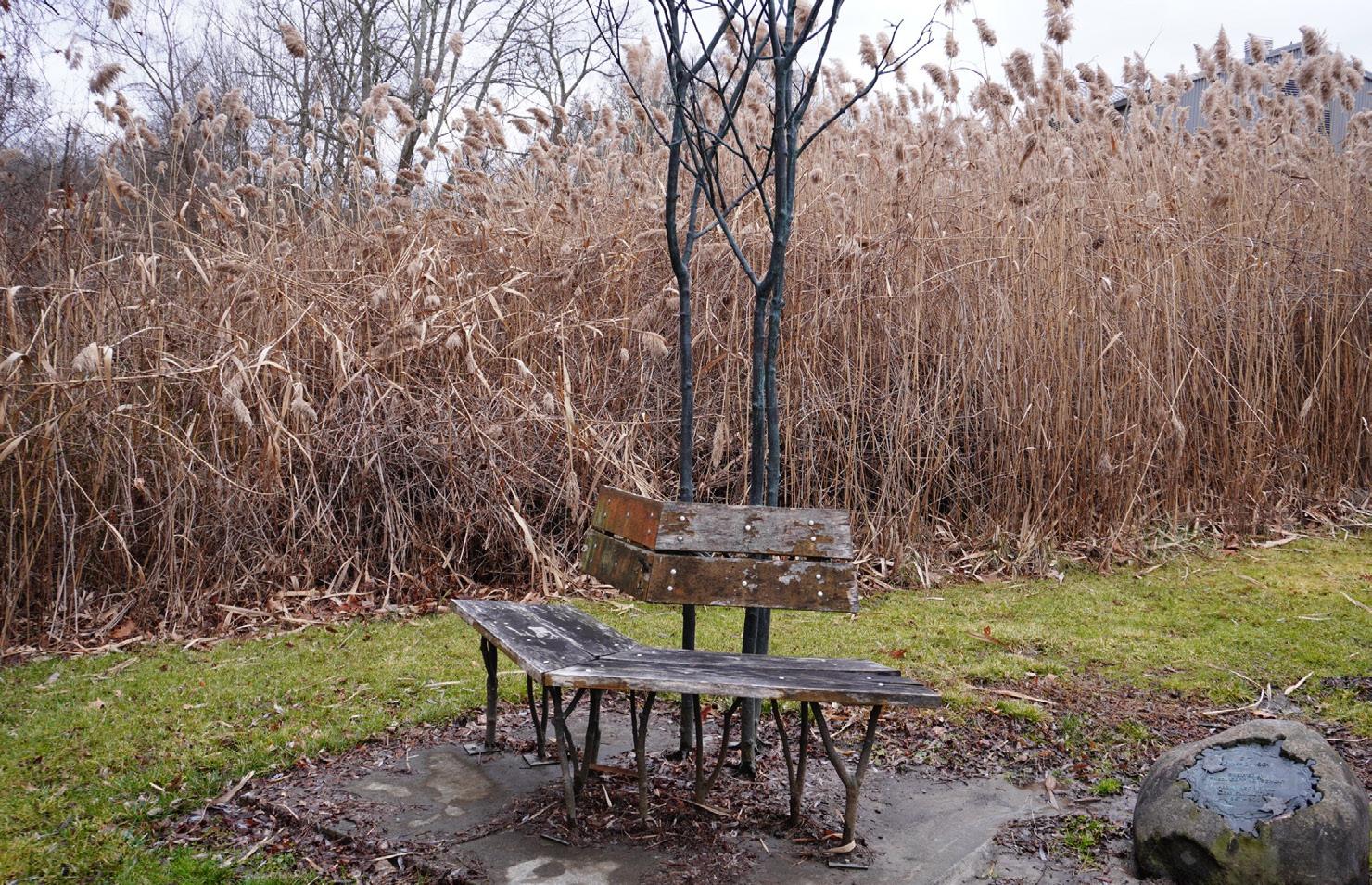
 Luke Jenkins Guest Columnist
Luke Jenkins Guest Columnist
Leo Tolstoy opens his famous “Anna Karenina” with the now iconic line: “All happy families are alike; each unhappy family is unhappy in its own way.” This quote has evolved from a simple opening line in Tolstoy’s 1857 book to a novel philosophical concept that says in order to succeed in any area or discipline, a series of unavoidable conditions must be met. This idea, dubbed the Anna Karenina principle, has been applied across a wide variety of fields, from gender disparities in STEM to the stock market. It is with this principle in mind that I bring up a subject as wholly complex as family dynamics: relationships with benches. Specifically, relationships with the maze of benches dotting the Vassar campus. While it might be more fruitful to interact with Tolstoy’s claim in a substantial and scholarly way, is it more fun? I hope to persuade—through a series of bench-themed overtures, an interview with a fellow bench enthusiast and an unbridled passion for sitting on wood surfaces—that good benches and happy families are indeed, very much alike.
Descending the hill towards Sunset Lake is where we encounter one of many “good” benches, and my personal favorite. It sits quietly to the right of the road, just before a curious onlooker would traipse across the bridge. Why do I hold this particular seat near and dear, its splinters cloyingly plucking at my heartstrings? I believe it’s a perfect embodiment of Tolstoy’s “happy family”—the only minute difference being that it’s not a family, let alone a person. The qualities that demand this label? First, its view of the lake, positioned so I barely spy
people from my perch. This leads directly to my next reason: a desired level of privacy. I see nary a soul lugging packages from Central Receiving, but my ears twitch just enough at the crunching of gravel that I’m not completely detached from reality.
As I daydream of a far-off spring break in Palm Beach, it’s of pressing importance that my butt isn’t fatigued. The contours of the wood or metal that make up any “good bench” must melt into my tailbone. I must sink into the structure, like I’m popping a squat in quicksand, melding into a grotesque pile of flesh and bench frame. Only then can one ascend into an almost heaven-like ecstasy.
When evaluating the success of a bench, it is worthwhile to explore the bench’s purpose. Different benches serve different functions. What makes a good bench out-
have a most-frequented bench.” One bench, on the side of the Nircle near Cushing, she holds close to her heart. “I like to cry there.”
When searching for a good crying bench, Hammarhead prefers one material to make up the seat, saying, “I’m looking for wood.”
As for another type of bench, of the “contemplative” variety, Hammarhead notes, “You don’t want a back ’cause you want to be able to sit up straighter and really connect with the world.” It is this attention to detail that cements Hammarhead as a talented bench connoisseur, with an eye for the essentials.
One final, paramount quality to consider for the success of a bench’s longevity is an untainted past. If one is dumped on a bench on Joss beach or caught crying as a tour walks by the Chapel, a bench’s aura
is permanently changed. The little bench bubble you spent a semester blowing up could very well pop in your face. In these situations, it is important to stress the ebbs and flows of one’s college career, and the ebbs and flows of the presence of a certain bench in your life.
A great bench, that satisfies the conditions explored above, is an important refuge, but not an effective shield from turmoil. It is a great parallel to the way a “happy family” isn’t a shield from the events of life. Putting aside shallow standards, benches are places in our environment where healthy coping mechanisms can be put into action. A place to call your mom, to cry, to contemplate and to struggle through a close reading of “Anna Karenina.”
side the library isn’t what makes a good bench on the boardwalk. Sadie Hammarhead ’26 is a strong believer in compartmentalizing benches that have different functions. “I have a favorite bench and I
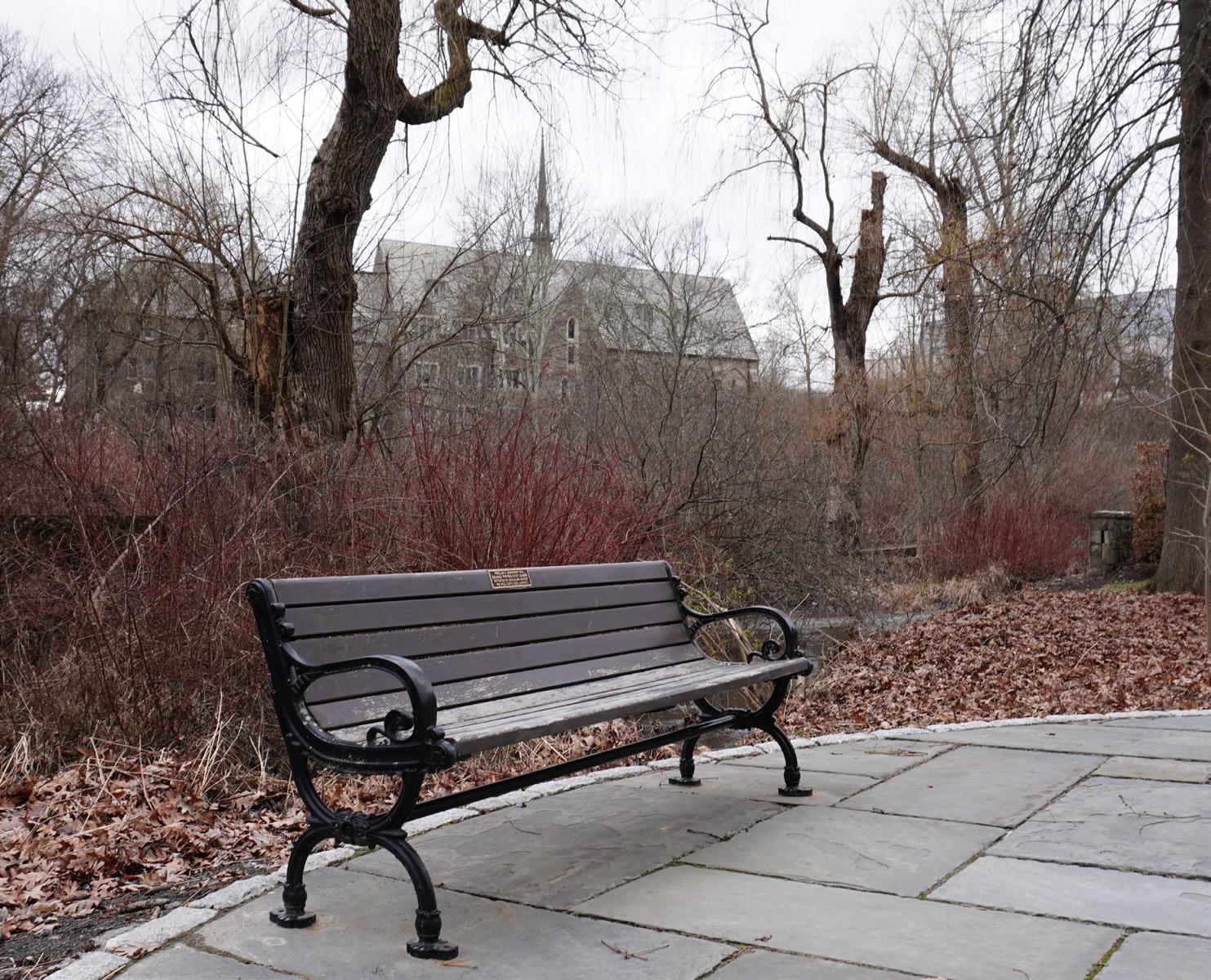

"A great bench, that satisfies the conditions explored above, is an important refuge, but not an effective shield from turmoil."Image courtesy of Sadie Hammarhead ’26. Images courtesy of Catherine Phillips ’26.
The story of how I won the storage wars
Alyssa Willeford A Fighter, not a LoverMostVassar students make one crucial mistake during their time here: acquiring possessions. Oh, yes, it seems like a good idea to buy a towel to dry yourself off with, and flip-flops so you don’t get athlete’s foot while you dry yourself off, and laundry detergent so that your towel doesn’t smell like hot pits—but, as any good religious philosopher could tell you, worldly possessions are a fool’s game. The fact is, you may get to thoroughly enjoy your large collection of anime body pillows during the semester, but then, come summer, you’ll have to store them somewhere. And that was where I went wrong.
It seemed like a good idea, like a natural thing to do. I had gotten many dozens of friendly emails from College Truckers, one of the moving companies operating at Vassar last spring. So I decided to contract with them to store my many luxurious items (from the French designers Amazön and Targét), making sure to first carefully pack everything in the provided boxes. After all, because I was planning to study abroad, I would be gone for both summer and fall. Therefore, it was important that my collection of 250 gold-plated tongue scrapers
found a comfortable home while I was away. The trouble began, as it always does, when I came back to Vassar. I had received no communication from College Truckers for many moons, so I reached out to them, only to discover after a long interval that they believed that my items had been delivered in the fall. Communication was hampered somewhat by the fact that the crack College Truckers customer service team is located in
gry Americans. I made up for this by reaching out to them several dozen times a day, reasoning that if the squeaky wheel gets the grease, then I was going to squeak, dammit.
When my plane landed at JFK—never a good sign, by the way, in any situation—I refreshed my email and received a crucial notification: The company known as College Truckers no longer existed. Its website is live at the time of writing, and you could even try to schedule a pickup if you so desired, but the operation is kaput, finito, deader than the succulent I stored over the summer of my first year. Luckily, a friendly woman in the Philippines directed me to Jacob, the former CEO, to whom I was supposed to refer my inquiries.
mous collection of 18-inch-high “Nekopara” figurines is on the line, you gotta do what you gotta do.
Eventually, cowed by the prospect of litigation, Jacob connected me to Vassar’s former on-campus College Truckers representative, who told me that he could help me get my items, but also that he did not own a car. Doubting his ability to carry them from Fishkill to Vassar on foot, I instead asked a friend for a lift, and the three of us drove down together one morning. At last, I was reunited with my possessions. And you know what? My palette-load of sour cream and onion Bugles hadn’t even gone stale yet!
the Philippines, where enjoying lumpia and halo-halo is a far more enticing way to spend one’s time than answering emails from an-
So I did. Aggressively. I knew that Jacob, being far from the Philippines, could not be distracted by any delicious snacks, and yet he was even less responsive than the customer service department had been. Clearly, he was a mustache-twirling villain of the most heinous variety; perhaps he was enjoying my life-size anime posters for himself, or else fleeing to Brazil with my money. So I did what any reasonable, level-headed American does when confronted by the slightest inconvenience: I threatened to sue him, twice. I’m not proud of it, but when an enor-
So all’s well that ends well. Yes, the dastardly Jacob escaped punishment, but at least his terrible company is dead in the water. The “College Truckers warehouse” turned out to simply be a dirty, unheated self-storage unit—and, by the way, it was still filled with people’s stuff, so y’all really need to be a little more assertive. If you ever do make the mistake of owning something and need storage for said thing, do yourself a favor and reach out to the Vassar offices; they’ll recommend a reputable company. Now, if you’ll excuse me, I have a heavily-stained copy of “Shonen Jump” to leaf through for the five thousandth time. Ah, reunion is sweet…
I miss the old Express: A lament rooted in disappointment
It has been a little over five months since Express lost the right to serve hot food, an experiment which has, at best, made me very sad. For the majority of the roughly one and a half years that I have been on campus, Express has featured hot food items.
As a Main resident and self-proclaimed eater of hot food, I have had to move my appetite to The Retreat, something I am rather ambivalent about. Retreat has always felt to me like a backhanded name because the interior gives me recently-renovated gas station vibes (which is strange because it’s technically just a room inside Main). I think it’s fine if they want to embrace a gas station aesthetic, but if so, they should call the place something more fitting like “Quikstop” or “The Vass Zone.”
tions, all of which will inhibit your food journey. During non-peak Retreat hours there is ample space, which means I end up aimlessly walking around the place for far too long, unsure of what combo of four items to get. Express didn’t allow space for indecision, especially if there was, like, one other person there—you just had to get your food items and skedaddle.
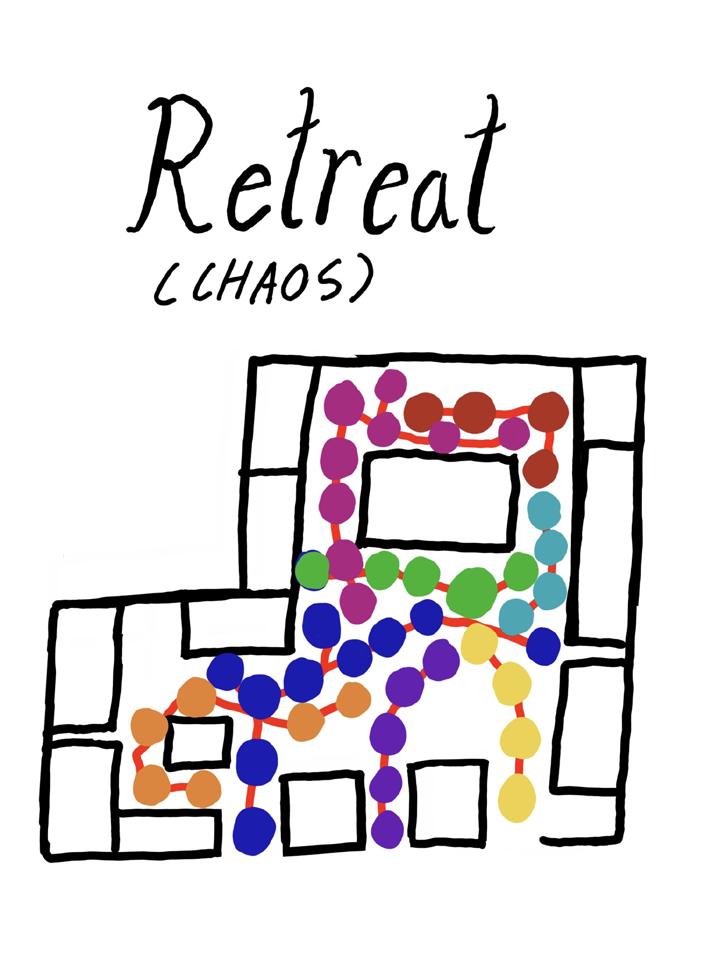
I eat at Express-side tables far more than Retreat-side, in part just because of how empty that side of Main gets now. Express has been practically deserted since it lost hot
Express will solve all of my problems, but it would solve most of them. Does moving the hot food to Retreat just kinda make sense? Was Express brutally inefficient at times? Certainly, but my nostalgia for the magic of Express remains.
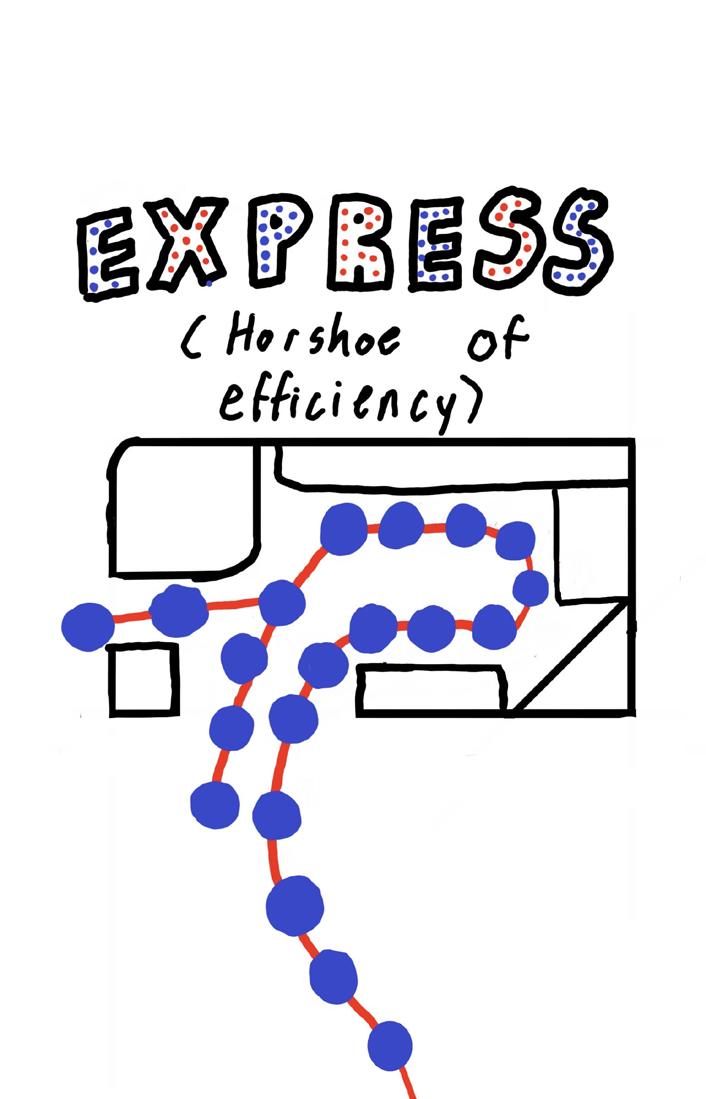
The move to Retreat has not been without good ideas, like a particularly Cheesy Thursday last week, in which it served both grilled cheese and fried cheese curds on the same day, while a vendor who I refer to as “The Cheese Guy” was selling cheese not far away. A Cheesy Thursday indeed.
In a lot of ways, I feel like I have lost a friend this past semester. We had some good memories, me and Express, like the brief time that there was not-whole-grain Pop Tarts, or the
great pizza burger or the first time there was premium Ronnybrook milk. In closing, I’ve written a short, open letter to Express: O humble food source, How might I express the ways we’ve grown apart?
You brought the fruits of my academic labor, the finest of campus chili and thine own cheesesteak. But over summer’s heat, you grew so cold, or room temperature in many cases. Although I accept Retreat's adoption, I can’t find solace in your dining options. Warmly, Disappointment.
food. I almost expect a tumbleweed to roll by. I haven’t been to Express in ages, but I wouldn’t be surprised if there were cobwebs on the shelves. Humor Editor Madi (my most unreliable source) claims that if you do go there, they will undoubtedly ask you why you went there when Retreat has more food items, so apparently you get judged at Express now, too.
Another thing I’ve noticed is that there’s far less linearity to navigating Express than Retreat. Express, at its peak hours, features a one-lane superhighway that bends into a horseshoe of efficiency. On the flip side, Retreat at peak hours can feature upwards of seven different lines in its interior, sometimes going in completely opposite direc-
At Express’ peak, Chicken Nugget Tuesday felt like a real fervor. The lines were atrocious and if you weren’t in line, you had to slip through a wall of people to get to class. It felt worth it for the nuggets, though. Like it or not, food becomes way more iconic if you’re forced to wait far too long for it.
Look, I won’t act like returning hot food to
From the desk of Madi Donat, Humor Editor
Excited to move out of theory and towards practice, students rail against societally-defined ideas of “due dates” and “attendance”
Nicholas Tillinghast Yearner
"You may get to thoroughly enjoy your large collection of anime body pillows during the semester, but then, come summer, you’ll have to store them somewhere. And that was where I went wrong."
"Express has been practically deserted since it lost hot food. I almost expect a tumbleweed to roll by."
"Express didn’t allow space for indecision, especially if there was, like, one other person there—you just had to get your food items and skedaddle."
ARIES
March 21 |
April 19
HOROSCOPES
Madi Donat Astral ProjectorExamine your vices and guilty pleasures this week. Are the things you like guilty pleasures because they are traditionally liked by teenage girls, or are they actually worth a healthy amount of guilt? I’ve been getting really into TikTok sadgirl music lately, which I think toes that line quite well. Something to think about.
TAURUS


April 20 |
May 20
The Food Truck has poutine! The one famous thing to come out of Montréal besides Celine Dion, and it’s pretty good (thanks, Eric Feeney!). Reimagine your international food consumption this week. Take a world tour with flavors. Spend exorbitant amounts of money on takeout. You deserve it, or whatever.
GEMINI

May 21 |
June 20
Obtaining things will not make you happy in the long run, but sometimes you can’t escape the sweet rush of a little gift from yourself to yourself. We as a society deny ourselves of little treats so often. It’s really sad. Do I think the solution to that problem lies in the Etsy.com instead of the reevaluation of consumerism? No comment.
CANCER
June 21 |
July 22
Connect with your basic human instincts this week. Sometimes all we need is to put our feet in water or dirt or dried beans (before you say anything, have you tried putting your feet in dried beans? No? Okay, so let me be the authority on this). Natasha Bedingfield was right when she said, “Feel the rain on your skin.”
LEO July 23 | August 22
VIRGO

August 23 | September 22
Your friends all love you, which is totally warranted, but this week you should focus on loving yourself, too! Take care of all your needs, even the ones you hate, like cleaning your room or calling the kind man who employs you and telling him you can no longer work for him on ideological grounds. That one’s just me? Okay.
LIBRA
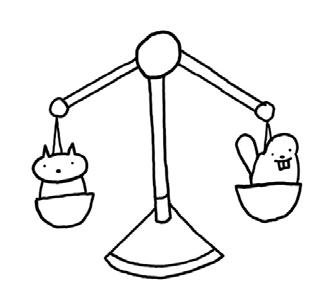
September 23 |
October 22
Being with people is awesome, but make sure to cultivate alone time. Not in the way where you isolate yourself as some sort of sadistic art installation, but more in the way where you feel okay with your thoughts and not like they’re gonna eat through your brain like maggots. If anything, your thoughts are adult flies.
SCORPIO
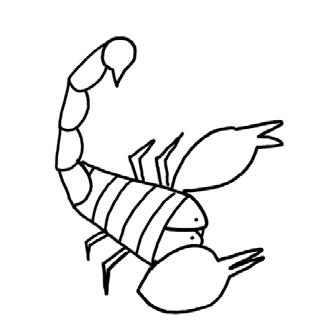
October 23 |
November 21
Horoscopes are out this 2023; instead of your horoscope, this week you should contemplate other words with the word “scope” in them, like “colonoscopy,” “telescope,” “rotoscope,” “episcopal” or the scops owl, which is very cute. All of these “scope” words will allow you to see in ways that “horoscope” simply can’t.
SAGITTARIUS
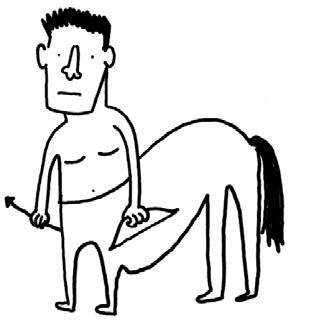
November 22 |
December 21
Sometimes school gets the better of us, and our bedtimes become precariously later and later without our consent. This week, reclaim your precious shut-eye by standing up for yourself! Say, “No, Brain, I will not go to bed at 1 a.m. and then wake up at 10 a.m. and feel bad about myself!” No idea if it works, but you might as well try.
CAPRICORN
December 22 |
January 19
To some, you may be overlooked, but to me you are perfect. Your symbol is a goat with a fish tail, like a mergoat. Who could overlook the beautiful mergoat? You have horns and scales! Who else can say that? The stegosaurus, maybe, but they are extinct and you are not. Capricorns will live forever.




AQUARIUS
January 20 |
February 18
Life is great even when grandeur isn’t involved. You don’t need to charm everybody or save all the pink dolphins to be a person worth existing; you are worth existing just because you exist. That said, though, if you want to save all the pink dolphins, no one’s gonna stop you. They could use some help.
Helping others is very kind, and being someone people can turn to makes you a big hit at parties. One thing to watch out for, though, is whether you’re actually helping or just asking if people need something because you think they’re doing it wrong. Leave the innocents at the Deece berry trough alone, you guys.
PISCES

February 19 |
March 20
There’s a fine line between a deep, interpersonal connection and latching onto somebody because their past parallels yours. We all have similar wants and needs and lacks and obsessions, but sometimes someone who is just like you will do more harm than good. This is about the question of whether you’d fuck a clone of yourself.
Making things weird: An admirable 2023 resolution
It is no secret that everyone's sense of humor is unique and different, and what we find funny varies greatly based on the person. Some find humor in cynicism, some find it in foolishness and I happen to find it in making people really, really uncomfortable. Well, that might not be entirely true, but it is a goal of mine for my last semester at Vassar.
I have spent the last four years trying to make people laugh. Have I succeeded? Meh, kinda?
I have written this column for the past two years, and whether or not anyone has found it funny is unknown to me besides? the occasional compliment that I awkwardly accept having forgotten what I wrote about that week the minute I turned in the article . And let's be honest—have I written about anything that is revolutionary? Absolutely not. My writing focuses on my own experiences with lying, being
a bad student and turning in late every piece of writing I have done for The Misc. Not very exciting stuff, but it gets the point across.
So during my final semester, having exhausted most of my attempts at humor, I have decided to just try being weird. I am not saying I am not odd already—everyone at Vassar kinda has their head in the clouds,in my opinion. But, this semester I am aiming to make people uncomfortable, for my own entertainment, of course. I mean who's to say I don’t already do this, but this time it will be on purpose. How will I do this, you ask? Still figuring it out, but I do have some simple ideas.
Of course, we have to start out with the classics. Prolonged eye contact, giving deadpan responses to lighthearted questions, starting conversations with total strangers—you know, easy stuff. Then we can start on the new stuff. I have never been great with interacting with people who I kinda sorta know, but total strangers
are really where the fun is. My goal this semester is to meet at least five new people, have a chaotic conversation where we discuss nothing and yet everything, and then
suggestion was to pretend to be a bouncer at parties and ask for IDs. I’m not sure how believable that would be, but hey, it could get a few chuckles. Another suggestion was to walk into a public restroom and say out loud, “It's ok, you can poop in here.”
Along the same line, it was suggested to run up to people on the Quad with a friend and ask them to guess who, out of the two of us, just soiled themselves. Obviously we are all aiming for some more highbrow stuff.
I am also trying to invest in some longterm awkwardness by repeating the same act in a public space and seeing how long it takes for anyone to notice. For the past week, every time I have passed by people walking into the Deece, I say, “You are in for a treat.”
ignore them when we walk past each other the next day in the Deece.
Struggling to figure out some other ideas, I consulted a few of my friends. One
Poetry Corner
Anna KozloskiUNUSUAL LODGING
The residents dare not inquire Why she spends every day on the spire; The last one who asked Unnaturally passed When she unleashed a monstrous lyre.
Who knows how strange these things actually are, but it is clear that my mark on this school will not be made with my academic prowess and my honesty, so I may as well make it a little bit weird.
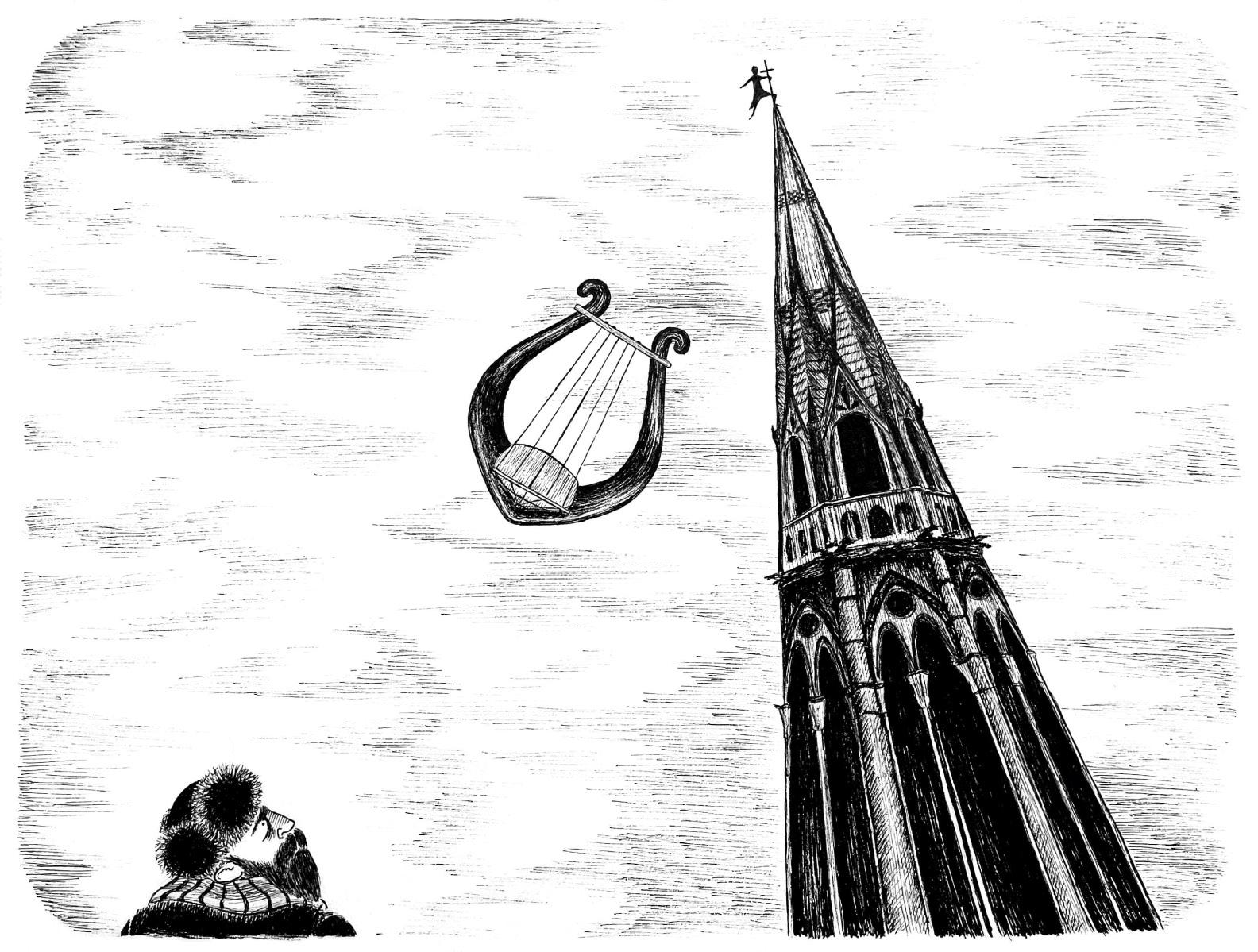
Carly D'antonio Installation Artist
"Of course, we have to start out with the classics. Prolonged eye contact, giving deadpan responses to lighthearted questions, starting conversations with total strangers—you know, easy stuff."
STICK FIGURES OF VASSAR
An exclusive interview with the Phantom Pisser
Nandini Likki, ExPEErienced Question-Asker
Reader, I have scoured everywhere in order to write this article. I have searched high and low for this fantastic fiend and their unique urethra, and I have finally found the Phantom Pisser. Those familiar with any dormitory bathroom will be aware of the Phantom Pisser’s work. Personally, I fondly remember some of their earliest pieces, such as “Midnight Micturate” and “Pee #5.” I sat down with the Pisser for this exclusive Miscellany interview.
NL: Thank you so much for talking to me today!
PP: Thank you! I’m so honored that you reached out to me.
NL: When you think of urine, what comes to mind?
PP: Well, a plethora of things. I think of majestic mustard fields. I think of sunshine pouring through clouds after rain. I think of leaves of the autumnal variety. Mainly I think of the color yellow. I mean, I’m not a traditional artist in the “I went to art school, and I know what color theory is” way. But Gandhi said, “Be the change you want to see in the world,” and I think that’s beautiful. You may not know this, but many people mispronounce “Gandhi” as “Gaandi,” which is funny because that actually means “asshole” in Hindi. Assholes aren’t the same as urethras, but I’ll be damned if they aren’t close.
NL: What a fascinating and convoluted answer. How did you get started in this line of work?
PP: If you think about it, the whole mechanics of flushing the toilet is so hackneyed and passé. Everybody’s done it, everybody’s seen it before. What if someone didn’t flush the toilet? What if someone dared to be different, dared to take a whizz on the wall of uniformity? I simply had to step up and be that person.
NL: Wow, truly profound. Now, to get down to the real stuff: What’s your policy on washing hands?
PP: Oh, against, for sure. Why burden my alabaster hands with the confusing yet sweet-smelling grime of soap? A simple “running my hands through the water briefly” will suffice.
NL: What would you say to those who question your motives and methods?
PP: In the famous words of Beyonce’s “Drunk in Love,” “We pee all night.” Everyone pees. Why shame the actions of another when we’re all the same, when we all love the same way? If you prick me, do I not bleed? If you tickle me, do I not laugh? If you poison me, do I not die? And if you pose a porcelain toilet in front of me, will I not fill it with piss?
NL: Are you quoting Shakespeare’s “The Tempest”?
PP: Ahh, ’tis not “The Tem-pisst”?
NL: No, ’tis not.
(An awkward silence ensues between us. Being brave, I soldier on.)
NL: Finally, what advice would you give those who want to follow in your footsteps?


PP: Anypee is possible.
And there you have it! Unfortunately, I cannot reveal the identity of the Phantom Pisser. As soon as I looked away from them to type up my last notes for this interview, they suddenly vanished, leaving not one yellow drop in their trace. Here’s hoping that, one day, the Pisser will be brave enough to reveal their face to the public eye. Until then, this is Nandini Likki, signing off.
Mindset change needed in age of COVID-19
 Britt Andrade Guest Reporter
Britt Andrade Guest Reporter
The last several years of COVID-19 have been peppered with the phrase “when things go back to normal.” When things go back to normal, we’ll be able to go to concerts again, we’ll be able to hug our friends without worry and we won’t have to wear masks again in class. We soothed ourselves with the idea that the pandemic was temporary, and the fatigue it brought would fade with a good time and some rest. Over three years later, with people still testing positive, maybe it's time to start looking for a new definition of normal. Maybe there’s a lesson in community care that we should be taking from the pandemic and carrying into the new year. That brings me to a question I’ve had since the start of the semester: How is Vassar handling COVID-19 now, and how can we be better as a community?
To address how Vassar is managing COVID on campus, I spoke with two students, who wished to remain anonymous, who tested positive for COVID-19 this past week. They happened to be roommates, so when the first student tested positive, her first concern was for her roommate. She called Health Service, but because it was right at the end of the business day, she was only able to speak to an on-call triage nurse in Massachusetts. While the nurse was kind, she wasn’t incredibly helpful, as a large portion of her information for Vassar was outdated. She believed Vassar was still placing students in hotel rooms and not letting them recover in the dorms. Because her roommate isn’t immunocompromised, the nurse informed her that it was safe to remain in her room. However,
it didn't matter much, as her roommate tested positive later that night. The second student wasn’t able to speak to anyone in Health Service until the next morning. They spent most of the morning on the phone with various offices trying to get added to the list of ill students so that they would be able to pick up food from the dining hall using a container pass. Both said they felt the initial reporting was the most difficult part—that while they knew to call Health Service, Vassar didn’t provide them enough resources to ensure the process went smoothly. Students who test positive are required to isolate themselves for five days and mask in classes and common spaces for an additional five days, according to Health Service.
The isolation process seems to be relatively simple, yet marked with pitfalls. How can we improve it? One simple solution is for Vassar to add a checklist to the Health Service web page of the steps that students in isolation need to take. It's an easy solution that requires little from the administration and would provide constant access to concrete instructions for the student body. I know we all got the emails—I also know those emails likely got buried or deleted amongst all the other emails we receive.
Additionally, I believe that we need to be providing more access to booster shots. The CDC recommends an updated booster six months after the last shot is received. If we are encouraged to get the flu shot every year, then maybe it's time to start promoting the COVID-19 booster in the same light. Health Service offered a COVID-19/flu shot clinic with Acme Pharmacy on Dec. 6 and 7; continuing to hold similar events twice
a semester could ensure that students get vaccinated, which could help to reduce illness on our campus overall. Partnering with a local clinic would also address concerns with access, as not all students have transportation to clinics, and the weather can be at its most obnoxious during cold and flu season.
Finally, we need to continue to encourage students, faculty and staff to wear masks when they feel ill, and provide accessible time off and care when it is needed. The burden of health safety prior to the
pandemic was always placed on immunocompromised students, faculty and staff. We, as a community, came together to protect each other, and we should continue to do so. A sniffle can be deadly, and even those of us with healthy immune systems have at-risk people at home. Now, in the confines of our collegiate community, is our opportunity to reshape how we view illness so that when we transition to the job market, we can carry that change with us, like little vaccines of kindness to a society in need. Stay safe and stay well.
Coming to terms with a field not designed for you
Donat Humor EditorClassical music has been held up by many as a bastion of Western culture, and, by some accounts, it is—the great works of compositional masters demonstrate what humans can achieve creatively when presented with the right resources, support and time. Even into the 21st century, watching someone who is truly a master of their craft perform, compose or direct allows one to revel in the ability of the human condition and where sufficient
practice can take you. This is not just the case for classical music, of course. I could easily make the same statement about athletes, painters, polyglots and the like—anyone who has pushed the body or the mind to its limits.
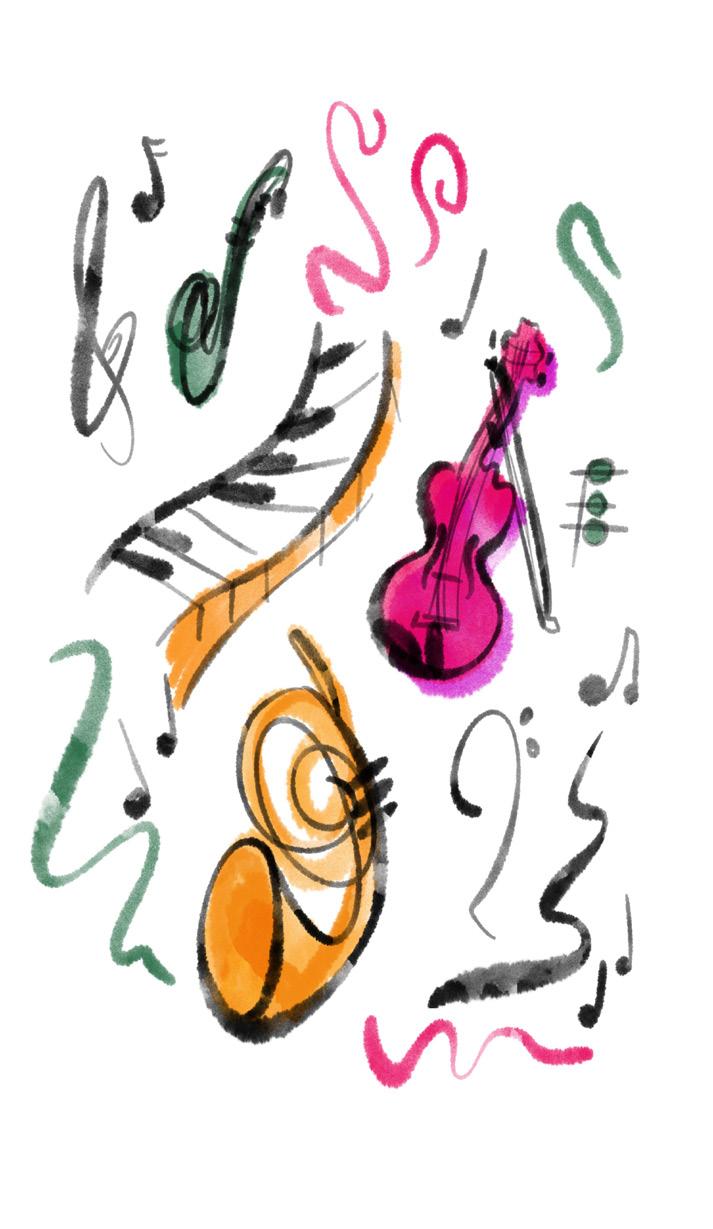
I love classical music. It has given me a home when I didn’t quite feel like I belonged anywhere else. My singing voice was always too dark for pop and too old-sounding for theater. Classical voice gave me the space to be scary, to be loud, to take up space. It also honed my capacity to listen intently, analyze deeply and understand the myriad of socioeconomic factors that go into making great art. I feel endlessly fulfilled in my field and would not trade it for the world, but it does sometimes strike me how classical music was only designed for an incredibly small collection of people.
The business of classical music is just as important as the art—after all, the great composers would be no-names were they not published, funded and supported. There were, for hundreds and hundreds of years, two main “companies” that provided adequate financial resources for the composition and performance of classical music, those being royal courts and the Church. Choir music, my chosen field of specialization, would be nothing if not for the support of the Church. Almost all choir music, from its inception in the 13th century onward, is sacred. Many choral composers did write secular works, but the historical and cultural core of choir music is inherently rooted in Christianity.
It is, of course, also rooted in masculin-
ity, in a way. The funding and support of male composers were impossible to achieve for most women who were making and writing music. For women, music was to be done in the home, privately, to add to a roster of skills that would position them as a good wife. Those who performed concert music publicly were considered “low,” and those who played music at the royal court were called “courtesans,” a word which all-too-quickly became synonymous with “prostitute.” Success in classical music was predicated on being a white, Christian man.
This is not to say that exceptions did not exist—Salamone Rossi, the one Jewish composer you will read about in your music history books, if you read about any at all, wrote madrigals and other polyphony for the court. Composers such as Fanny Mendelssohn Hensel and Clara Schumann utilized their proximity to famous men composing at the time to get their works published and otherwise in the public eye. But for others, there was not a place in classical music for a very long time.
As a choir singer who has no plans of going professional, my two options for postgraduate singing are community choirs or churches. Community choirs are notoriously underfunded, and, while many have proven social and emotional benefits for members, are not often considered as “serious” or “proper” as the church choir. In addition, a community choir will not pay you to sing. Most likely, you will have to pay to be a member—sometimes multiple hundreds of dollars a year. On the contrary, church choirs are more likely to be
well-funded, and, if you’re good enough, will pay you to participate. I’ve done it, and I like it—you get to meet nice people, and you get paid a small fee. But I can’t shake the knowledge that I, in my Jewishness that I hope is not too obvious or annoying, am not welcome and do not belong. During sermons, the pastor will tell us to spread the gospel. Save souls, all that. My friends, raised Christian and knowing by now how to filter out the bad parts, have trouble understanding why I’m so uncomfortable. Sometimes I wonder whether it would be better were I not to go.
Balancing my identity with my field can be hard, and I know that it is likely much harder for those who, instead of being listed in the margins of Western classical music history, were simply not present at all until extremely recently. Sometimes, I wish I had chosen a field that better holds these stories or had documented them better. It can be really hard to know that professional classical singing may cause me to have to hold my religion and identity at arm’s length. I often wish I were just grateful for the opportunities given to me—I’m lucky I even get paid to sing, after all—rather than complaining about how I don’t feel included. There’s no easy fix to this. It’s a slow and tiring road, one that has thankfully been explored by musicologists and directors before me and that I hope to investigate more in my postgraduate studies. Until then, though, we should try to engage with our fields through a critical lens and listen to those at the margins, especially in a field like classical music, which, compared to others, has a lot of catching up to do.
Chiefs, Eagles to face off in the big game
Doug Cobb Sports Editor
The 2022 NFL season was full of crazy ups and downs, but now we are left with two teams remaining: the Kansas City Chiefs and the Philadelphia Eagles. Although this year saw lots of upsets, unexpected ascensions and collapses, and dramatic storylines, football fans ended up with the number one seed from each conference as the last teams standing. The AFC-champion Chiefs earned the conference’s number one seed by finishing 14-3 in the regular season, and they finished first in the NFL in both scoring and total offense, according to Pro Football Reference. The NFC-champion Eagles were also the number one seed in their conference by finishing with the same 14-3 record. The Eagles finished second in the NFL in both scoring and total offense, behind only the Chiefs, but the Eagles also finished third in total defense (the Chiefs were a middling 12th). It is safe to say that we ended up with the best team from each conference playing in the Super Bowl, but how did they get here?
Philadelphia Eagles
The Eagles have had just about the most straightforward run to the Super Bowl possible. They were the best team from the beginning of the year when they started the season a perfect 8-0, and even after collecting their first loss they still kept rolling, going on a five-game winning streak. Their only real hitch came when quarterback (QB) Jalen Hurts injured his shoulder and missed two games, both of which the Eagles lost. However, he was able to return in the final week of the season to lead the Eagles to a win against the New York Giants that secured the number one seed in the NFC and a first round bye in the playoffs. After their week off, the Eagles showed no rust, annihilating the Giants in the divisional round and knocking out the San Francisco 49ers with similar ease in the NFC Championship Game. It should be noted that the 49ers lost their starting QB Brock Purdy (who himself was already the third stringer) early in the first quarter to an el-
bow injury. Then they lost their backup Josh Johnson to a concussion early in the second half, leaving them without a capable passer. But the Eagles beat who was in front of them all season long, and they usually did it with relative ease.
The Eagles are a very complete team, with arguably the best offensive line (OL). The strength of their OL has allowed them to have a 1,000-yard rusher in Miles Sanders (1,269 yds, 11 TD) and has assisted the passing game to allow for two 1,000-yard receivers in AJ Brown (88 receptions rec, 1,496 yds, 11 TD) and Devonta Smith (95 rec, 1,196 yds, 7 TD). But the real star of the offense is the aforementioned QB Hurts. Hurts has had an outstanding season, and likely would have been a real threat to win league MVP if he hadn’t gotten hurt. Hurts is a dual-threat quarterback who had a career year both on the ground and in the air (66.5 completion percentage, 3701 passing yards, 22 passing TD to 6 interceptions, a passer rating of 101.5, 760 rushing yards and 13 rushing TD). Hurts, a former second-round draft pick, was the starter in 2021 where he put up pretty mediocre passing numbers. This year was seen as a prove-it year for him, and boy did he ever.
But the Eagles’ impressive roster extends to the other side of the ball as well. Their defense boasts a fearsome pass rush with players like Pro-Bowl linebacker (LB) Haason Reddick (16.0 sacks), defensive tackle (DT) Javon Hargrave (11.0 sacks) and defensive ends Josh Sweat (11.0 sacks) and Brandon Graham (11.0 sacks). On top of that, Pro-Bowl cornerback (CB) Darius Slay (3 INT) and Safety CJ Gardner-Johnson (6 INT, tied for league lead) hold down the secondary.
The Eagles are the most complete team in the NFL, and it is going to be hard to slow them down.
Kansas City Chiefs
The Chiefs, like the Eagles, also had a relatively smooth regular season. They did lose nail-biting games to two other AFC contenders, the Buffalo Bills and Cincinnati Bengals, which sowed some doubt about their dominance, but still cruised to 14 wins behind a
high-flying offense led by arguably the best player in the entire league, QB Patrick Mahomes. Mahomes is the favorite to win his second MVP in just his fifth season as starter. The run of dominance to start his career is unheard of. In addition to reaching the AFC championship in all of his first five seasons as starter, he has won the Super Bowl, has now reached two others, has led the league in passing touchdowns twice, has been named to the Pro Bowl five times, has an absurd 6416 record as a starter and has an inhuman career passing rating of 105.7. This season was easily his best since he won league MVP in 2018. In 2022, he threw for a league-leading 5,250 passing yards, had 41 passing touchdowns to just 12 interceptions, had a career best 67.1 completion percentage and finished with a 105.2 passer rating.
Although Mahomes doesn’t pose the rushing threat that Hurts does, he is known for making magic with his feet, dancing around to extend plays, scrambling when necessary and launching deep throws down the field while he flies around behind the line of scrimmage. That is why it was so potentially devastating when Mahomes went down with an ankle injury in the divisional round against the Jacksonville Jaguars. Kansas City fans held their breath when they saw Mahomes get his ankle crushed in an awkward position by a Jaguars defender and then exit the game. Backup QB Chad Henne played admirably in Mahomes’ place, but every Chiefs fan exhaled deeply when Mahomes returned to the field later in the game. Kansas City held on to win the game, but afterwards tests revealed that Mahomes had a high ankle sprain. His status was never in doubt for the AFC Championship Game against Cincinnati, but his ability to use his agility for some Mahomes magic certainly was. The Chiefs were able to pull out a thrilling victory in front of their home crowd with a heroic effort from Mahomes, but he was clearly hobbled. With two weeks until the Super Bowl, it is certainly reasonable to think that Mahomes’ ankle could see some improvement, but it is a serious injury that definitely will not heal fully by then. Mahomes made
some great throws and had a gutsy run at the end of the game to set the Chiefs up for the game-winning field goal, but it was obvious that he could not move around very well. On top of Mahomes’ injury, the Chiefs lost their top three receivers (Juju Smith-Schuster, Kadarius Toney and Mecole Hardman) to various injuries during the AFC Championship Game, as reported by Yahoo! Sports. Their status for the Super Bowl is unknown as of right now. That could prove to be disastrous against the powerhouse pass rush of the Eagles.
Aside from Mahomes, the Chiefs’ offense saw solid production from running back Isiah Pacheco (170 rushing attempts, 830 yds, 5 TD) and wide receiver Juju Smith-Schuster (101 rec, 933 yds, 3 TD), but the real dominant weapon was tight end Travis Kelce. Kelce had his usual incredible season with 110 receptions, 1,338 receiving yards and 12 receiving TD. The Chiefs do not have a defense anywhere near as dominant as the Eagles, but they are led by All-Pro DT Chris Jones (15.5 sacks) who can occasionally will the defense to make big stops, as he did with his key sacks against Joe Burrow in the AFC Championship Game.
For the Chiefs, a Super Bowl win would put them on the path to becoming a dynasty and would only add to Mahomes’ unreal legacy. For the Eagles, a win would mean a validation of their dominant regular season and would be the cherry on top to Jalen Hurts’ magnificent breakout season. Both teams absolutely earned the right to be in this Super Bowl. Although the Eagles benefitted by playing in a considerably weaker NFC and did not have to face a real quarterback in the NFC Championship Game, I think they will win the Super Bowl. A fully healthy Chiefs team can beat anybody, but I am doubtful that Mahomes will be close enough to 100 percent to be able to avoid the Eagles' fearsome front seven. Additionally, with the status of his top receivers in question, I don’t expect him to see many open targets. This will force him to hold the ball longer and inevitably end up taking sacks because he won’t be able to extend plays with his feet.
The Miscellany Crossword
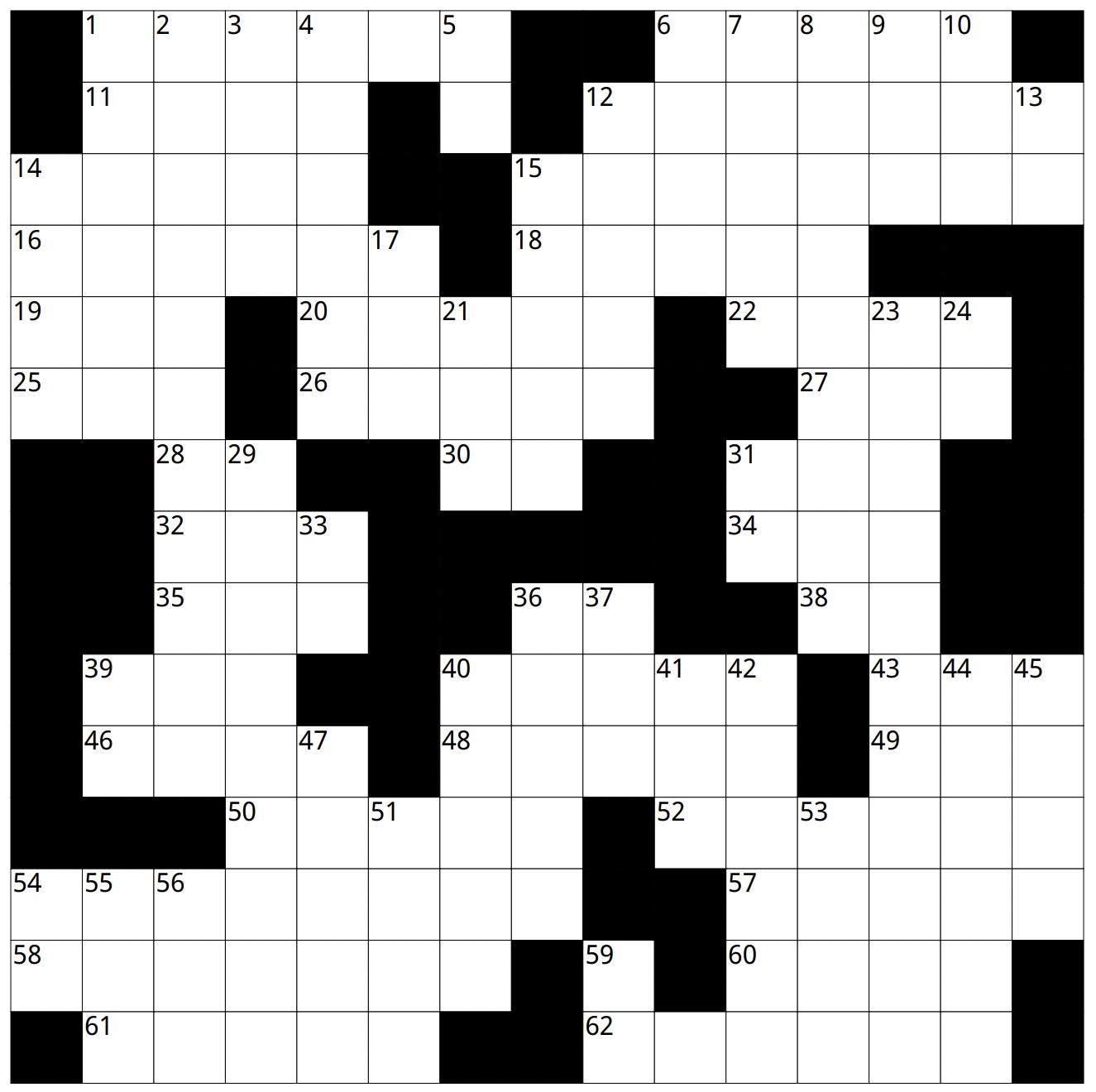

“Go With the Flow”
By Harrison WalkerACROSS
1. Environmental wonder or environmental menace, depending on the usage
6. “__ ___, so good.”
11. Ex-Yankee Martinez
12. Italian River that Caesar famously crossed, making it used as an idiom for “going too far ”
14. Really upset
15. Western border of southern California that passes through the Hoover Dam, forming Lake Mead
16. Here and there, in footnotes
18. Freshwater endpoint or stopover for a river
19. Fifth Edition D&D feature offered at levels 4, 8, 12, 16 and 19 for most classes
20. “Full steam ____!”
22. The border between the living and the dead
25. Himalayan or Appalachian, abbrv.
26. Many rulers of Russia, Nicholas II for example
27. A river's bottom
28. !eip __ ysaE
30. Support group for those with drinking problems
31. Creators of “You've Got Mail”
32. Annoy
34. https://miscellanynews.org
35. Committee of Soccer Moms and Lawnmower Parents, abbrv.
36. Precedes “F ” to make a versatile file
38. Vassar's response to Yale in November of 1967
39. Vassar's “campus-wide initiative dedicated to building communities of belonging, inclusion, and equity at the college.”
40. ’Tis but a ____ wound.
43. Entertainment Org. behind “Raw ” and “SmackDown!”
46. Africa's most famous floodplain
48. Vowels
49. Stephen of The Crying Game and “Breakfast on Pluto”
50. First Lady before Michelle
52. Improvises
54. Rivers from the heart
57. The Union of the Hammer and Sickle, missing an “i”
58. The border between Boston and Cambridge, MA
60. Frankfurt's RIver
61. A bottomless pit of gloom and despair (as mythologized at least)
62. They decide what goes where in a city
Answers to last week’s puzzle:
"The Study of..."
By Monika SweeneyDOWN
1. Someone will generally propose this at a wedding reception (2 words)
2. Mark Twain's meandering muse
3. They preface -logy, -lyze and “-gram"
4. The signs on page 11
5. Dreaded Knights of “Monty Python and The Holy Grail” use this utterance to scare travelers
6. Pout, or be bad tempered
7. Double-reeded woodwinds
8. Often promised to witches
9. Obamacare legislation abbrv.
10. Serling of “The Twilight Zone”
12. As opposed to streets, lanes, drives or avenues
13. Number, abbrv.
14. Unwanted calls or emails
15. Red Cross founder Barton
17. Frequency unit, abbrv.
21. Aircraft enthusiast org
23. This colorful body of water is the second longest of its kind in China
24. Dying of Laughter, to a texter
29. Class of large and heavy long-ranged military weapons
31. Gold, to a chemist
33. With ba and akh, comprises the essentials of a human soul in ancient egyptian religion
36. Statements submitted as “Guilty ” or “Not guilty ”
37. As an acronym, some of 39A's core goals
39. Turns nouns into adjectives
40. Price for a bus or train
41. “__ _ wise guy, eh?” (2 words)
42. ____ River School, a mid-19th century art movement, 45D's counterpart
44. SI units for magnetic flux
45. O'Keeffe painted this river more than a dozen times (and the Loeb has #3!), 42D's counterpart
47. Between Marquesses and Viscounts
51. 180 degree turns
53. A vein of metal ore
54. Vassar dorms don't have it, making August quite difficult
55. British earbud producer
56. The key above caps lock
59. Your location when it doesn't seem like Kansas anymore
